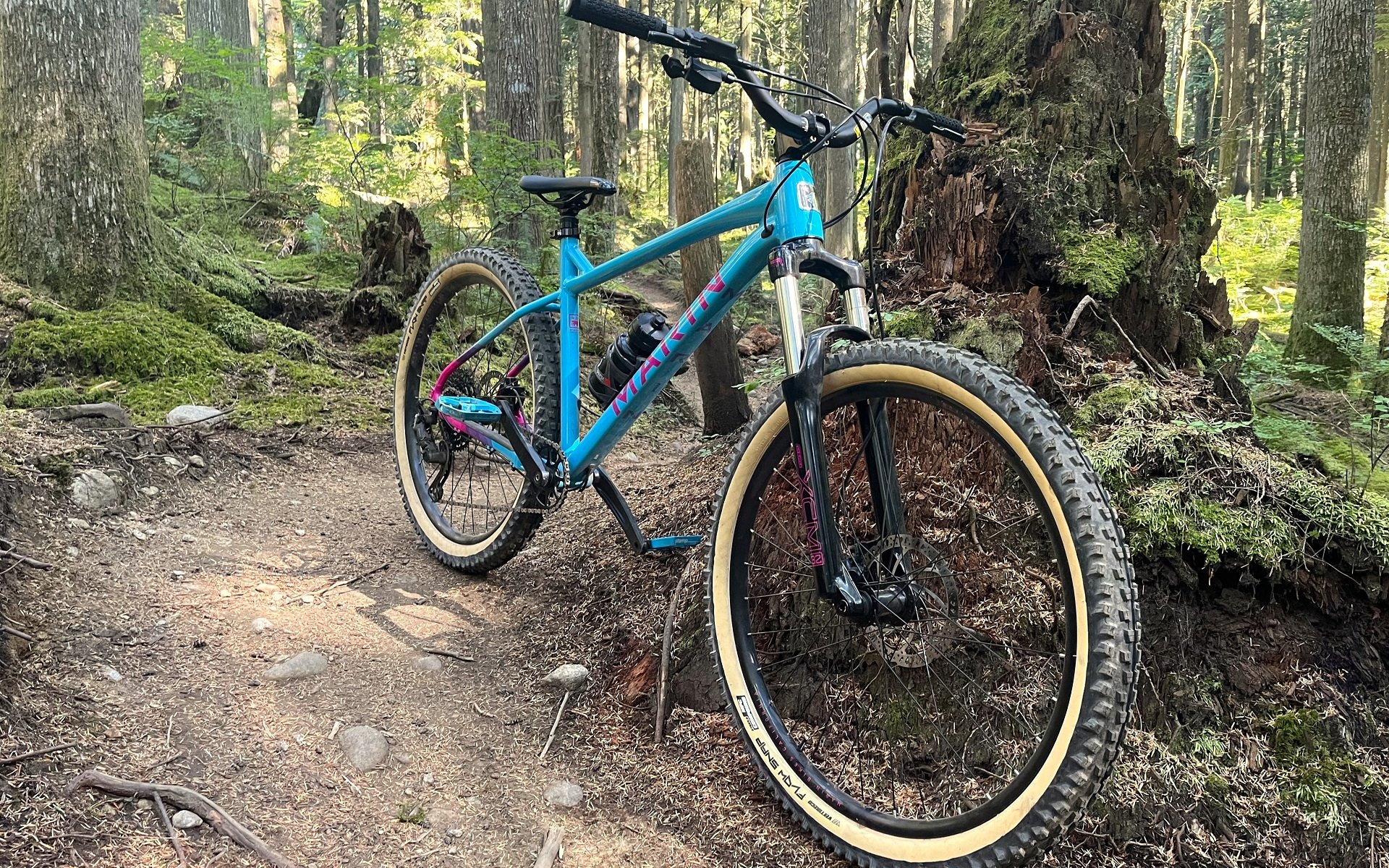
Budget Bike Review
The $1100 (USD) Marin San Quentin 1 Hardtail
Forking Indecision
I've spent more time thinking about the spec. of this Marin San Quentin 1, than any bike I've reviewed. Probably more than any bike I've owned. The geometry is solid because good geometry is free. The MicroShift drivetrain is solid because it's the best shifting and most durable option below the price of Shimano Deore. The Tektro M275 brakes are reliable and easy-to-bleed, with performance that meets my expectations for a 1350 CAD | 1100 USD mountain bicycle.
The 27" wheels make sense to me for the application and the Vee Rubber wire-bead tires aired up tubeless easily enough. Tires would be an early upgrade but I don't think I'd want to spend a North Shore winter on any tires included on a bike at this price. The Marin-branded i29 rims and handlebar (5° up, 9° back, 780mm wide, 28mm rise) are solid choices that appear on their bikes for double the price. In fact, the only real complaint I have with the SQ1 is the crankset. That wasn't always the case though.
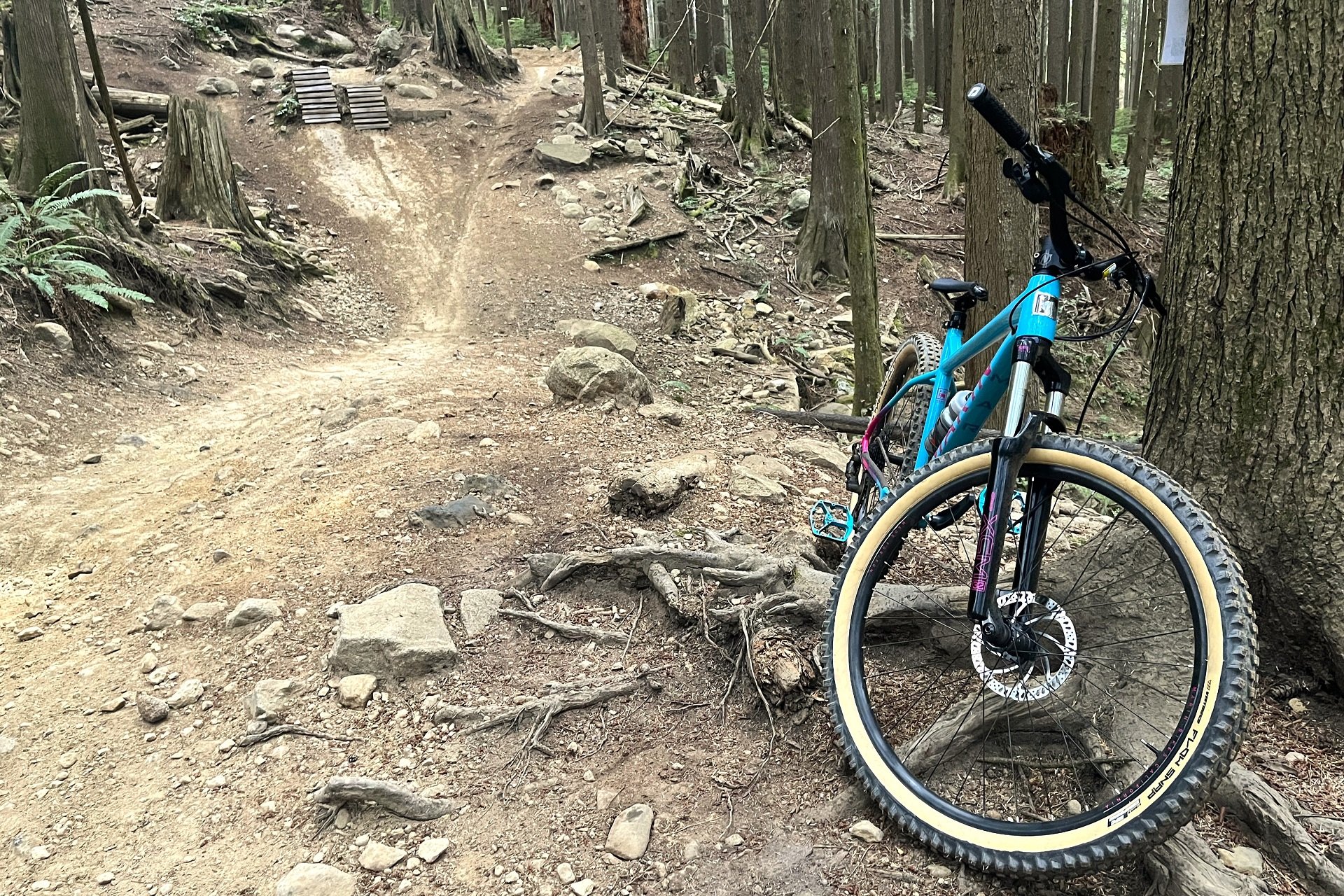
I happily rode the Marin San Quentin 1 on any Blue-level trail on Vancouver's North Shore as well as a couple of Purple-level ones. It's a great handling, confidence-inspiring, bicycle. In the past, I've always taken budget hardtail review bikes down a couple of proper Black-level trails as well but I wasn't there in body or spirit this go-around.
During the first few rides, I was writing endless notes about how the SQ1 should really come with a proper Plus-sized tire, a 2.8" or 3", a proper wide i40 rim, and a rigid fork. Bonus points if the said fork is painted to match the bike. I still believe that if the intention of the bike was for more-advanced riders to be paying an American grand for a bike, rigid would be a great way to go. But, as a few of my bike shop friends pointed out, this bike is not for me. It's for folks who are breaking into mountain biking on a tight budget, trail riding casually, or simply wanting a solid bike that doesn't limit future options as much as a hybrid or more basic hardtail, and none of them is buying a bike without a suspension fork.
I transitioned to thinking the SQ1 and SQ2 should be combined into a single rig that splits the price difference between the two; keep the MicroShift drivetrain and Tektro brakes of the SQ1 and add the RockShox Recon air fork and better crankset of the SQ2. If you're going to have a suspension fork, it might as well be one with an adjustable spring rate. There's precedent to this build; it's almost exactly what Marin did with the 24" wheeled version.
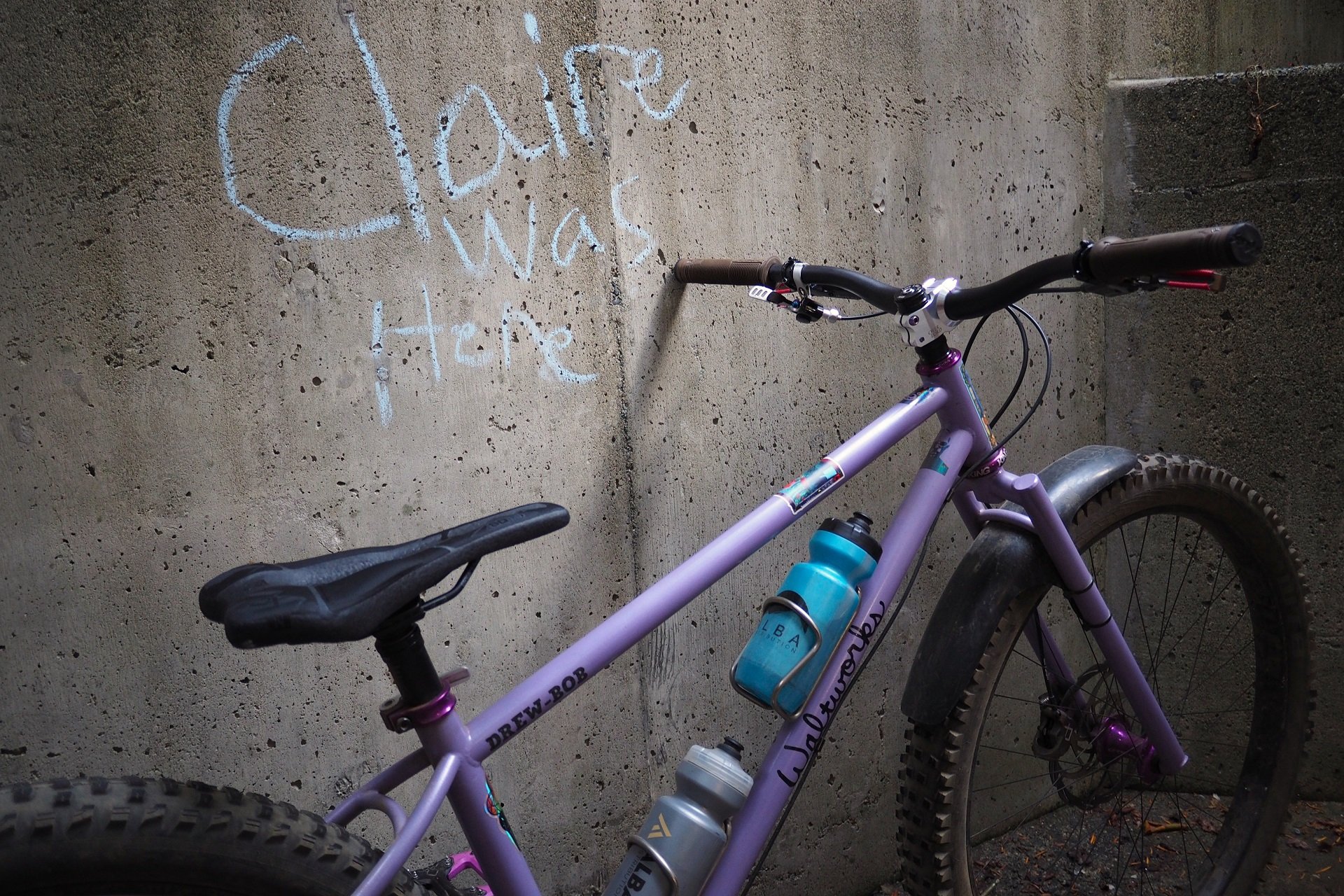
I know, any excuse to post my Waltworks V2. I simply can't ride a truly-budget suspension fork without thinking about all the benefits of a rigid fork with a big 2.8" or 3" Plus tire. Lighter weight, significantly lower maintenance, and maybe a few bucks left over to spend on other upgrades.
I came around to the truly-basic coil SR Suntour fork following two interactions with my youngest brother. He's never had an interest in mountain biking - he does lots of other cool stuff - but my nephew is beyond keen and he's a good dad. We were going for a ride at Thornhill, Maple Ridge's little gem of a mostly-Blue-trail network, and he asked me to bring a shock pump because the fork on his over a decade-old bike was fully flat. For a person who's maintaining a hundred other things in their life, staying on top of keeping the air pressure in bike tires is enough to remember. Being able to adjust sag or any weight savings with an air spring is secondary to grab-and-go performance.
The second event was when he actually borrowed the SQ1 for a ride. The geometry, tires, brakes, and suspension were forgiving enough that he followed my daughter into a few lines that surprised me, given his relative riding experience, with zero drama. Even with the fork lowers freshly Slickoleumed he didn't use close to full travel but the fork takes the edge off and it's probably for the best that geometry was mostly preserved. With an SQ1 he could happily take his kid riding a few times a month, or more, and never think about anything but putting air in the tires and a bit of chain lube in between yearly tune-ups.
Because geometry is key, even a less experienced rider will be able to grow into having fun on any Blue-level trails they can find on this bike. The rider who gets the bug will want to make some upgrades, like adding a dropper post as I've done, and tires especially if they're riding in the greasy season, and maybe eventually a more advanced suspension fork. Or, more likely, they'll turn their SQ1 into a backup or sell it to another aspiring mountain biker when they decide to buy something more aggressive. I don't see most folks truly enjoying riding Black-level trails on the stock SQ1, so given the use case, I came around to being fully on board with the fork spec.
...it's nice that I know I can recommend the San Quentin as a gateway bike to an aspiring or casual rider and know that as they develop their skills and confidence there's not a Blue-level trail out there that they won't be able to enjoy on this bike."
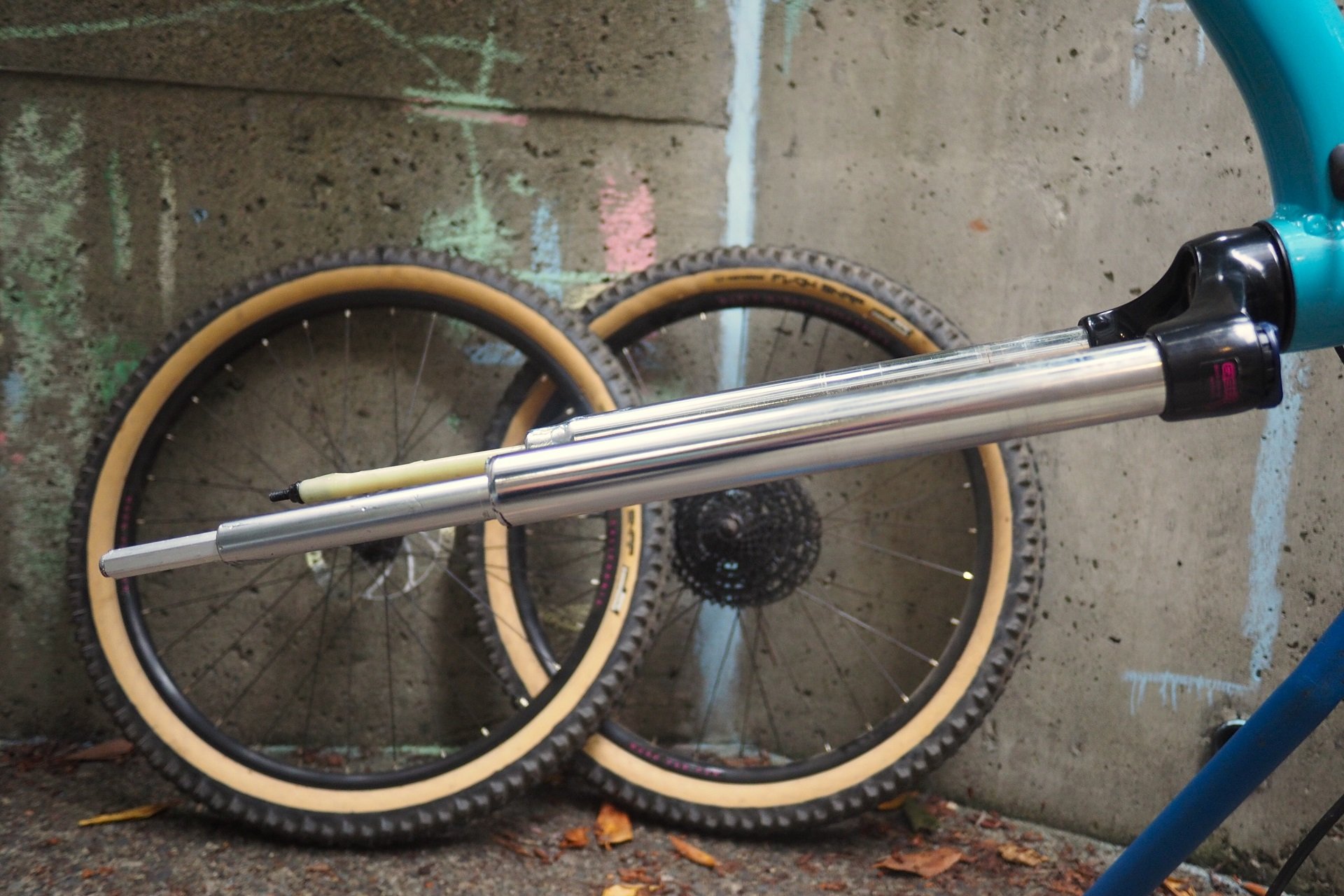
The SR Suntour XCM series forks are basic but that doesn't mean they don't benefit from a proper clean and fresh grease. I used Isopropyl Alcohol and Slickoleum.
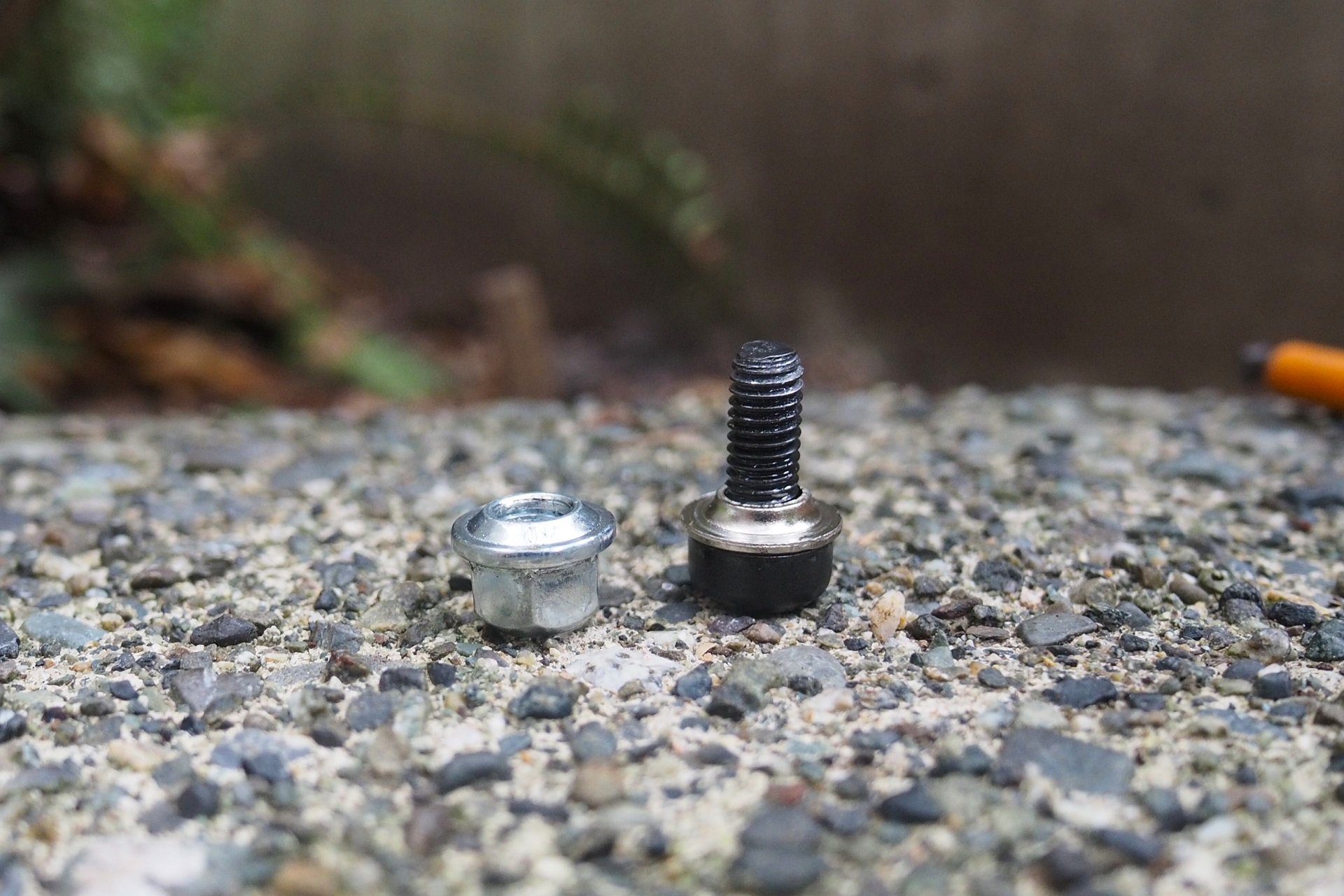
Simple and smart, the XCM has the least number of parts possible. I like the beveled nut, as an image that shows there's thought put into these basic suspension forks.
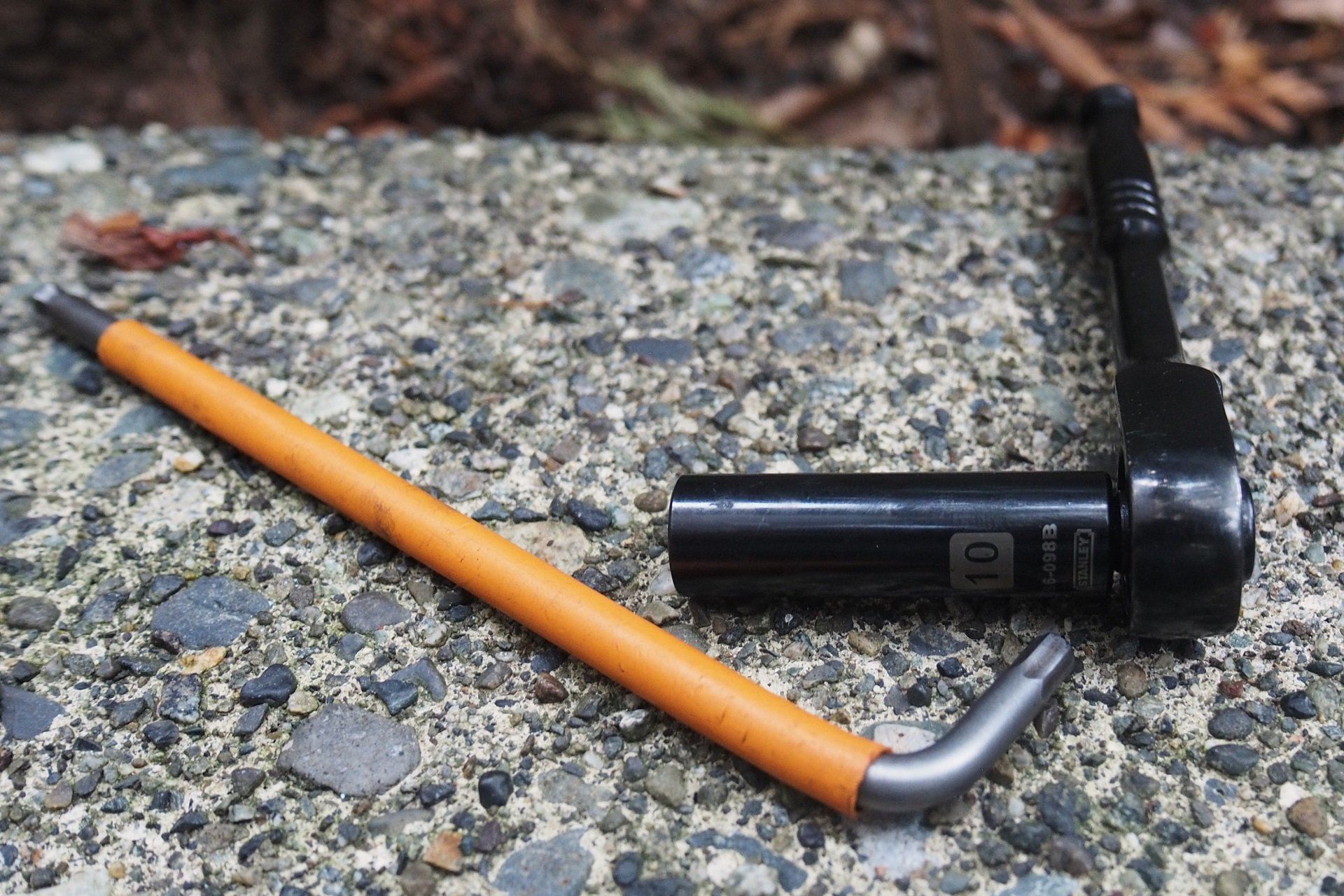
All you need is a 5mm hex key and a 10mm socket. Okay, I also used a rubber mallet to do a bit of thwacking.
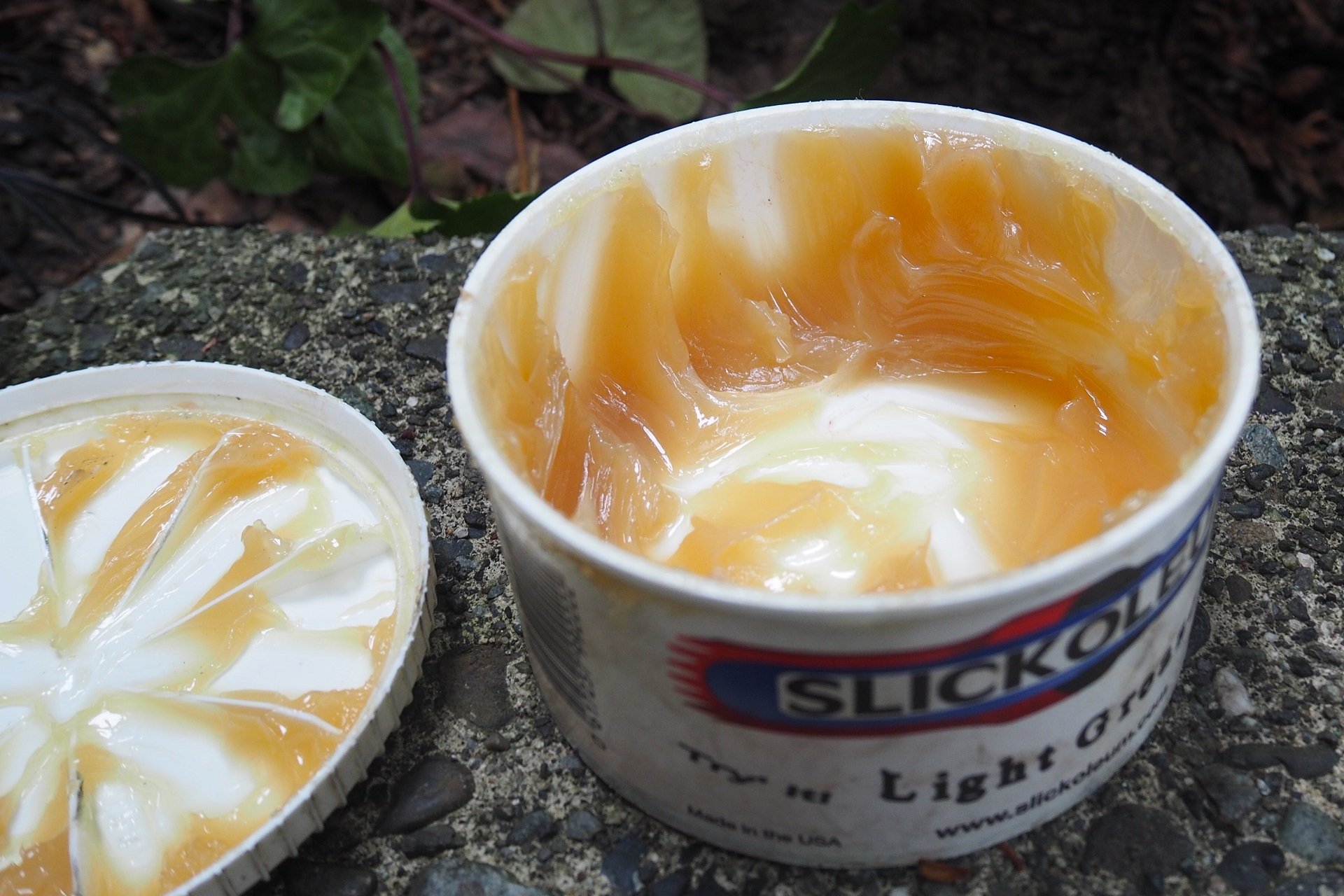
Reminder to order a fresh container of Slickoleum. Since I always get asked, like most local shops I buy it from SuspensionWerx.
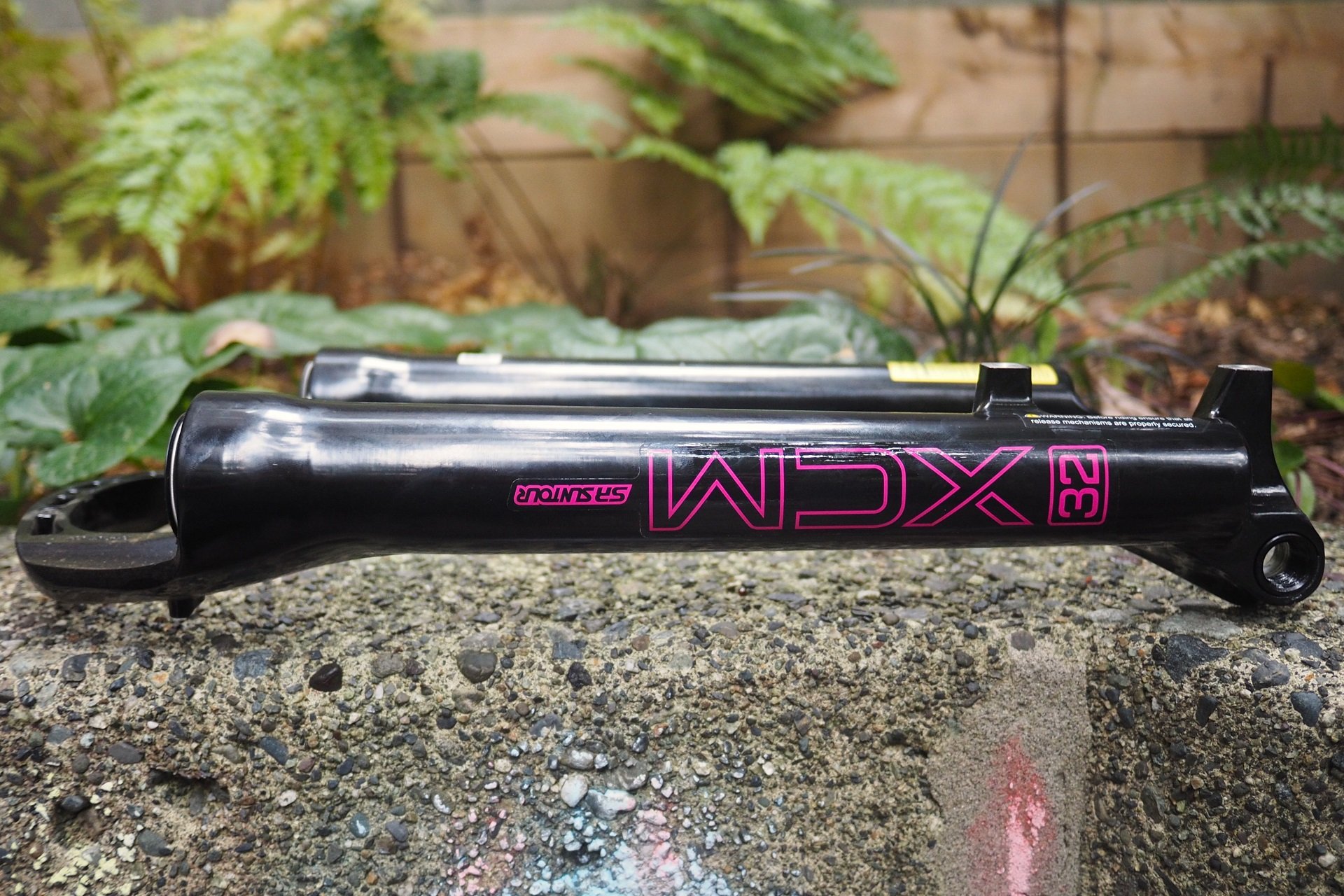
I didn't replace the fork seals but rather just cleaned them up with the Iso and then Slickoleumed the heck out of them.
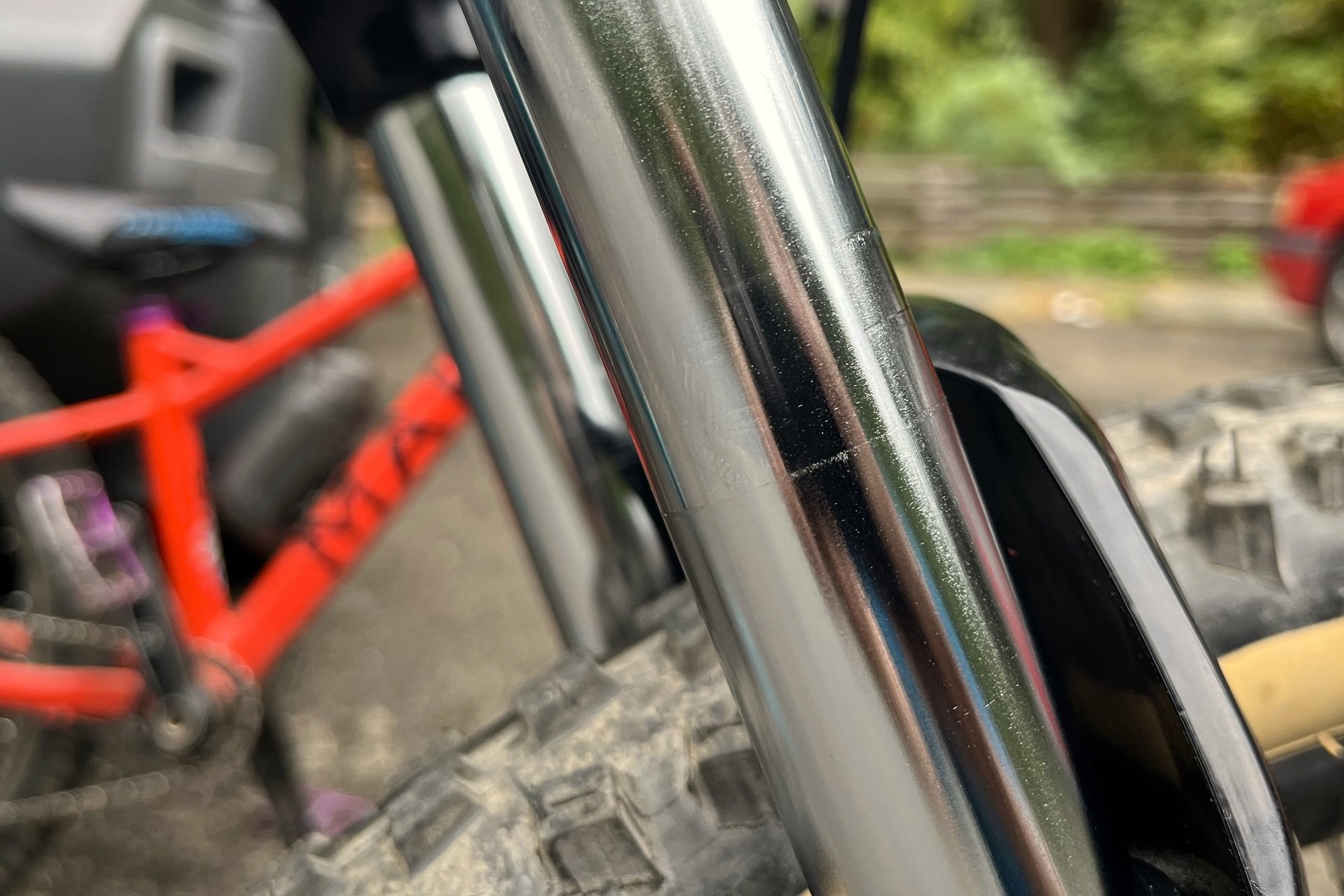
For the first one or two rides, there'll be a bit of excess lube purged, just wipe it off with a dry cloth. Small price to pay for the smoothest XCM in town.
On Value
As I discussed in my piece about buying a budget bike, it's easy to fall into the trap of just saying "for a few dollars more..." again and again. Or at least, it's easy to do so when comparing bicycle purchases in theory. It's 'only' another 600 CAD to jump into a San Quentin 2 but that's actually a 45% increase in cost. The San Quentin 3 has great tires, Shimano 4-piston brakes, a RockShox Revelation, an X-Fusion dropper, and the only drivetrain that matters for just 2900 CAD. It's a great value, but it's also an increase of 1550 CAD or 115% over this SQ1. The balance between budget creep and worth-every-dime upgrades is going to be very rider specific. But a complete Marin San Quentin 1 costs about the same as a 2022 RockShox Lyrik Ultimate fork, and only one of those things is going to be fun to ride down any level of bicycle trail.
I don't think the SQ1 reflects a great value for a rider who's aspiring to hit hardcore-hardtail-worthy lines on Black and Double-Black trails. By the time a rider upgrades the brakes, rubber, and crankset, they'd be pretty close to the investment into that SQ3. Of course, by the time you're into 2900 CAD for the SQ3 the proper-slack, steel framed 29" El Roy is only a couple of hundred dollars more. Budget creep.
But I go back to my brother's use case and think that if his kid does get more into riding, the SQ1 frame is worthy of a couple of hundred dollars in rubber, or better brakes, and even a great basic fork like a Z1, Yari, or Aion 35 somewhere down the trail if it becomes the case of needing a little more performance to keep up with the grom. At the same time, if mountain biking is just a phase, the San Quentin 1 is a great investment in a bike for camping, riding around the neighbourhood, or earning that six-pack with a quick pedal to the local beer store.
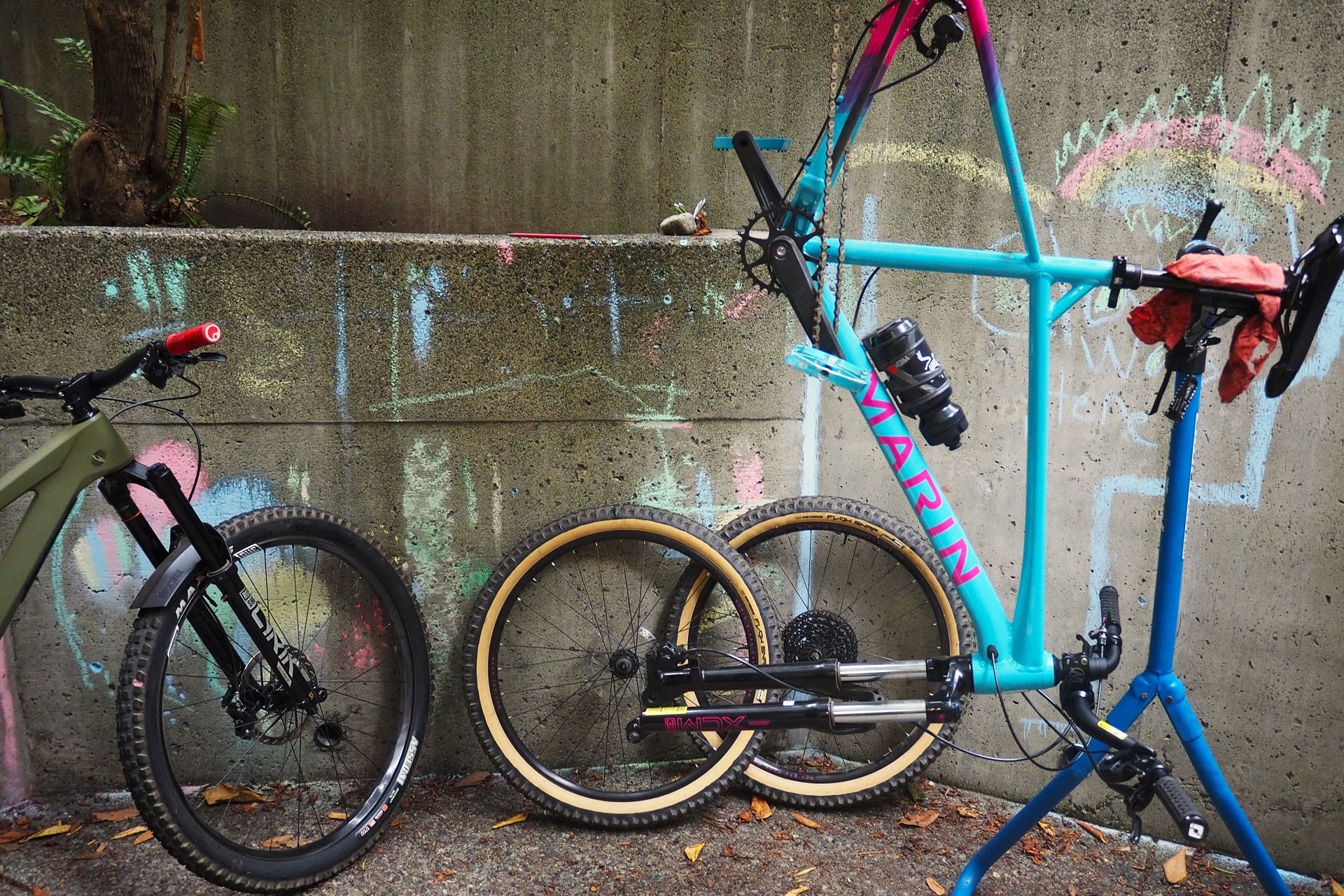
A new RockShox Lyrik Ultimate fork, like the one on the front of this We Are One Arrival 152, sells for about 1050 USD. For an extra half a hundy a whole Marin San Quentin 1 can be yours.
I've had some interesting conversations about MicroShift over the course of testing this bike. For the life of me, I do not understand why Shimano is not making a clutched version of their Alivio M4000 mountain bike drivetrain. Maybe they're worried it will cannibalize Deore's 11-speed and 12-speed sales. Maybe it's in the works but like everything Shimano, it's massively delayed at the moment. Either way, I'd argue they'd sell thousands and thousands more Alivio setups than they will the new wireless Di2.
In the meantime, there's MicroShift. And if you haven't ridden a MicroShift drivetrain, at least in a parking lot, I would recommend doing it. It's clunky, the shifting has to be very deliberate, the clutch does not work as well as a Shimano. It's a quiet enough, robust, totally acceptable setup that frees up a lot of purchasing dollars to spend on good tires, good brakes, and even a dropper post.
As such, I think Marin should have made the whole San Quentin series MicroShift, and spent the difference on other upgrades. Standardize the drivetrain, i29 Marin rims, house-branded riser bar, and a half-way decent 24mm spindle external-bottom-bracket crankset through the lineup and we could see better rubber on the SQ2 and a lower price, better brakes, or a fork upgrade on the SQ3. MicroShift Advent is not impressive in the same way that Deore M6120 is compared to high-end drivetrains but it's good enough. On the note about the crankset, I did drop a chain twice on the SQ1 but I blame the chainring rather than the MicroShift clutch.
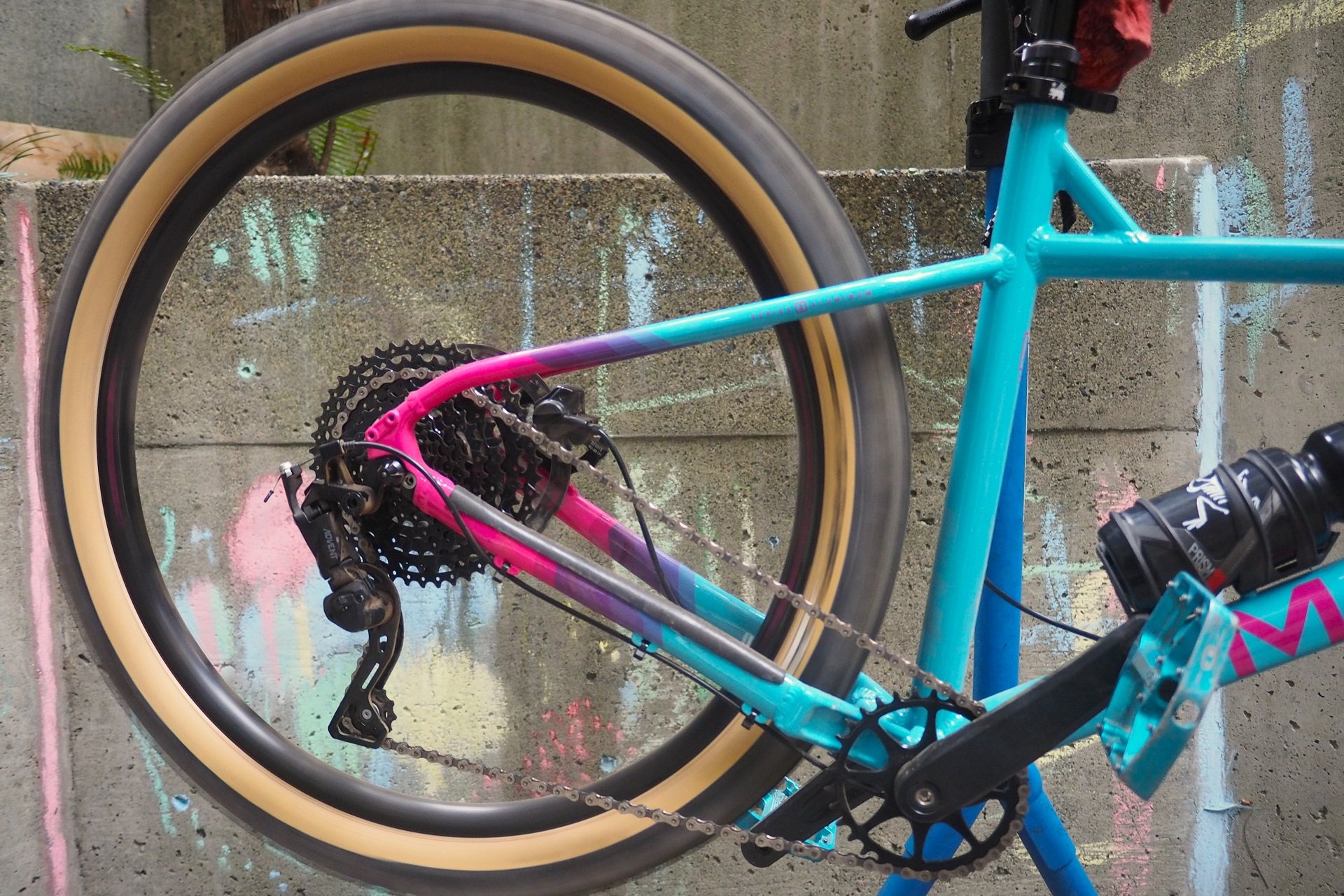
The SQ1 sports a 32x11-46t nine-speed MicroShift drivetrain. Even with the 27" hoops I can't help but think a 30t would have been a better choice for more riders but personally this worked great.
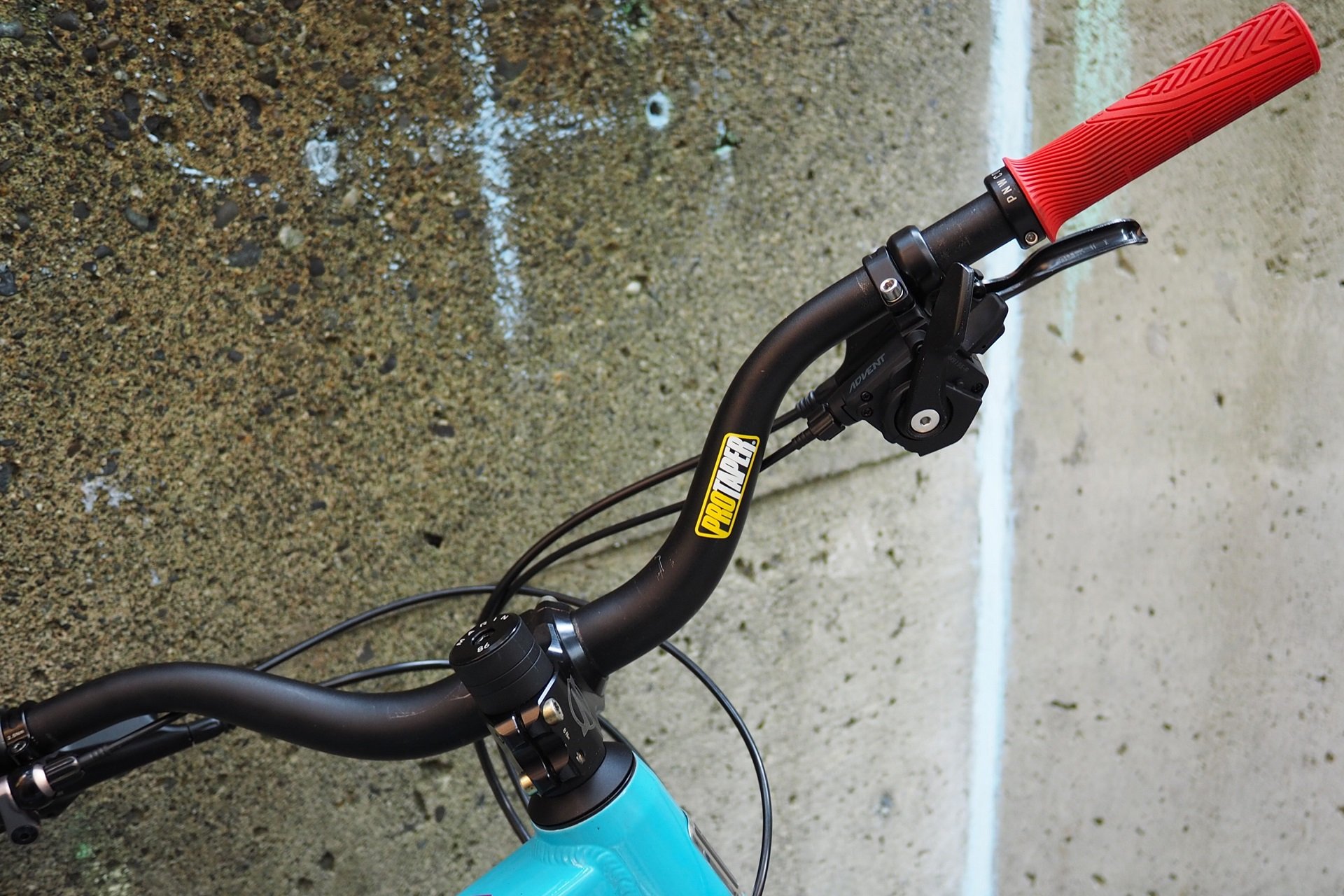
MicroShift Advent nine-speed shifting is very deliberate and requires the rider to be the same. Hero shifting is not rewarded, especially going back-to-back with Shimano's HG+ setup. It is, however, excellent for the outlay.
The Tektro brakes did require a pre-ride spiritual lobotomization coming from the Hayes Dominion A4, Formula Cura 4, and SRAM Code RSC brakes that I've been riding otherwise. Brake sooner, ride the brakes more, and don't expect nearly the same slam-and-go performance in corners. But then, a pair of Dominion brakes with rotors is well over half the price of this whole SQ1 even once pedals are added.
If this was my bike I would have left the stock resin pads out back and purchased some Kool Stop D-620S pads and a 203mm rotor for the front. These pads are sintered metal and while they run louder than the stock resin pads, they would enhance bite significantly. The stock pads and rotor would go on a shelf for future use on the rear of the Marin. A note on the D-620S is that it's also a great upgrade for the plethora of Shimano brakes that share the same pad shape (Shimano B01S and B03S) as the Tektro. Good resin pads are good - see Magura and Formula - but for these basic systems, a sintered metal pad is the way to go if you want to maximize power.

The Tektro M275 brakes use the same pads (B01S / B03S) as a number of Shimano brakes so spares are always easy to find. Even though they're a bit louder in use, looking at the available options, I'd jump on sintered metal pads when the time comes.
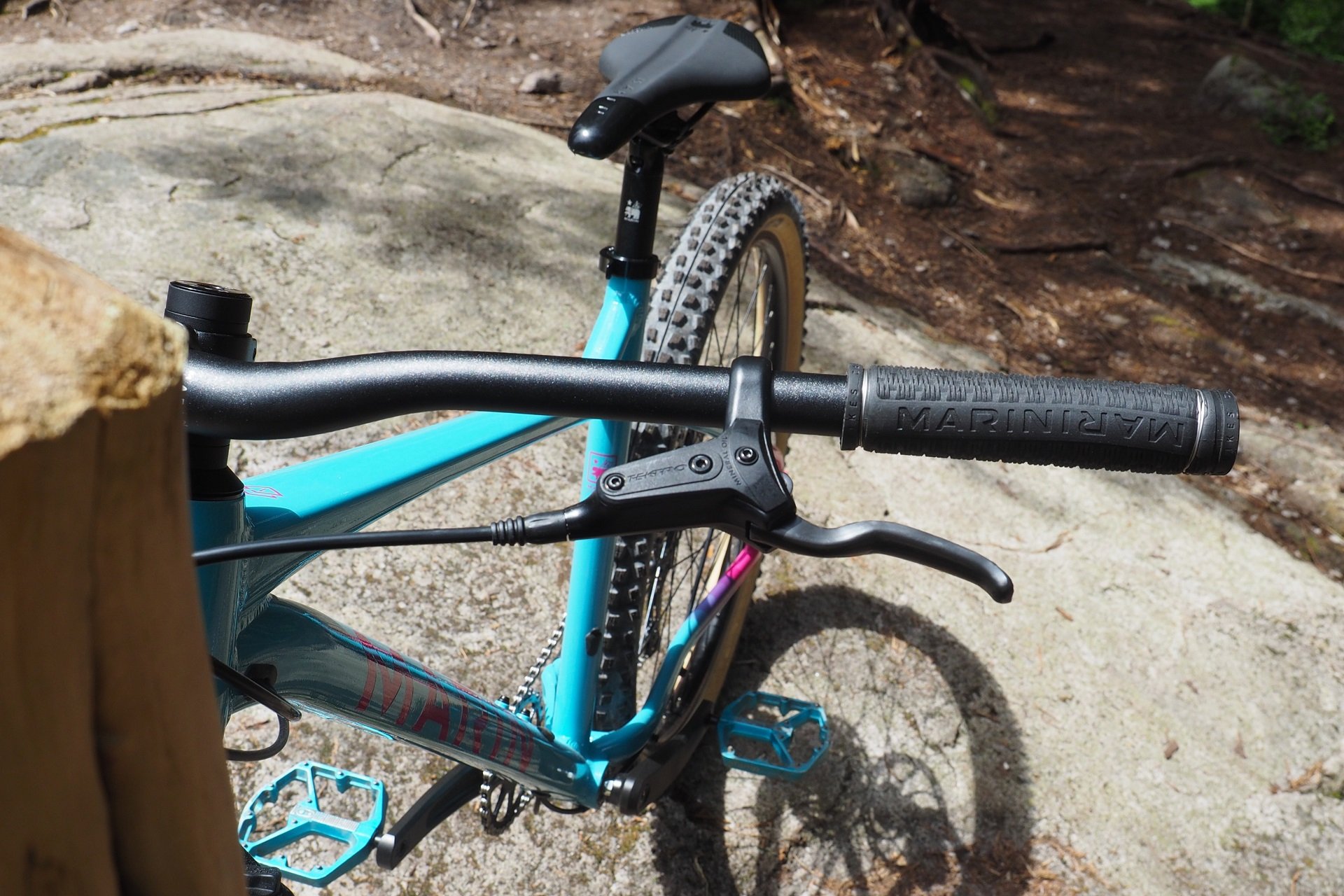
Longer lever blades for improved leverage. The brake levers don't feel bad at all and they're even relatively easy to bleed. My favourite thing about Tektro spec though is that I don't have to write about the absolute-shite 'Resin Only' rotors that everyone specs with budget Shimano brakes.
I love dropper posts. I didn't always. Now, I'd be happy to forget adjusting my saddle to never quite the right position with a quick release. As much as I didn't love trying to find the right pressure to balance support and traction with the Vee Rubber tires, other than putting on proper pedals, the only big change I made was throwing on a used dropper post. I thought of this as a personal luxury, an unnecessary little upgrade that would make it more enjoyable to ride the bike but my brother also really enjoyed having a dropper - certainly more than he noticed that the tires have less traction and support than EXO+ MaxxGrip rubber he's never tried.
I wrote a piece about braving the used dropper market, and I've really softened my tone on dropper posts coming as stock on more budget-friendly bikes. That means some other components are getting downgraded to hit the same price point but after watching my brother, I'd say a basic dropper would win over many other upgrades. A solid reminder that, while I enjoy riding and writing about bikes that cost less than high-performance suspension forks, these bikes are not being made for me.
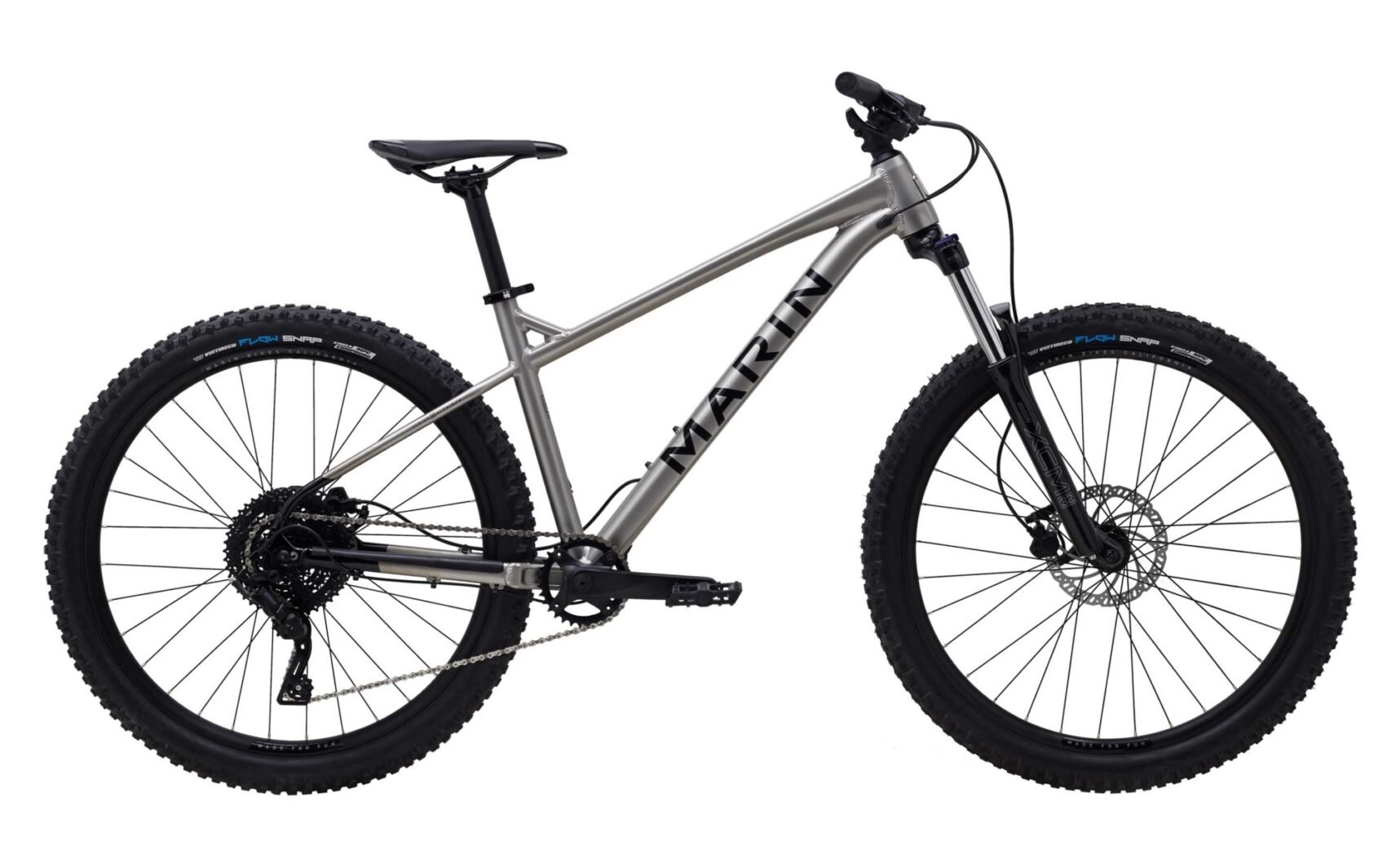
I'm recycling some captions I used for my piece on budget bike buying. Here's the alternate colourway of the Marin San Quentin 1 I'm reviewing here. Either choice of livery sells for 1350 CAD.
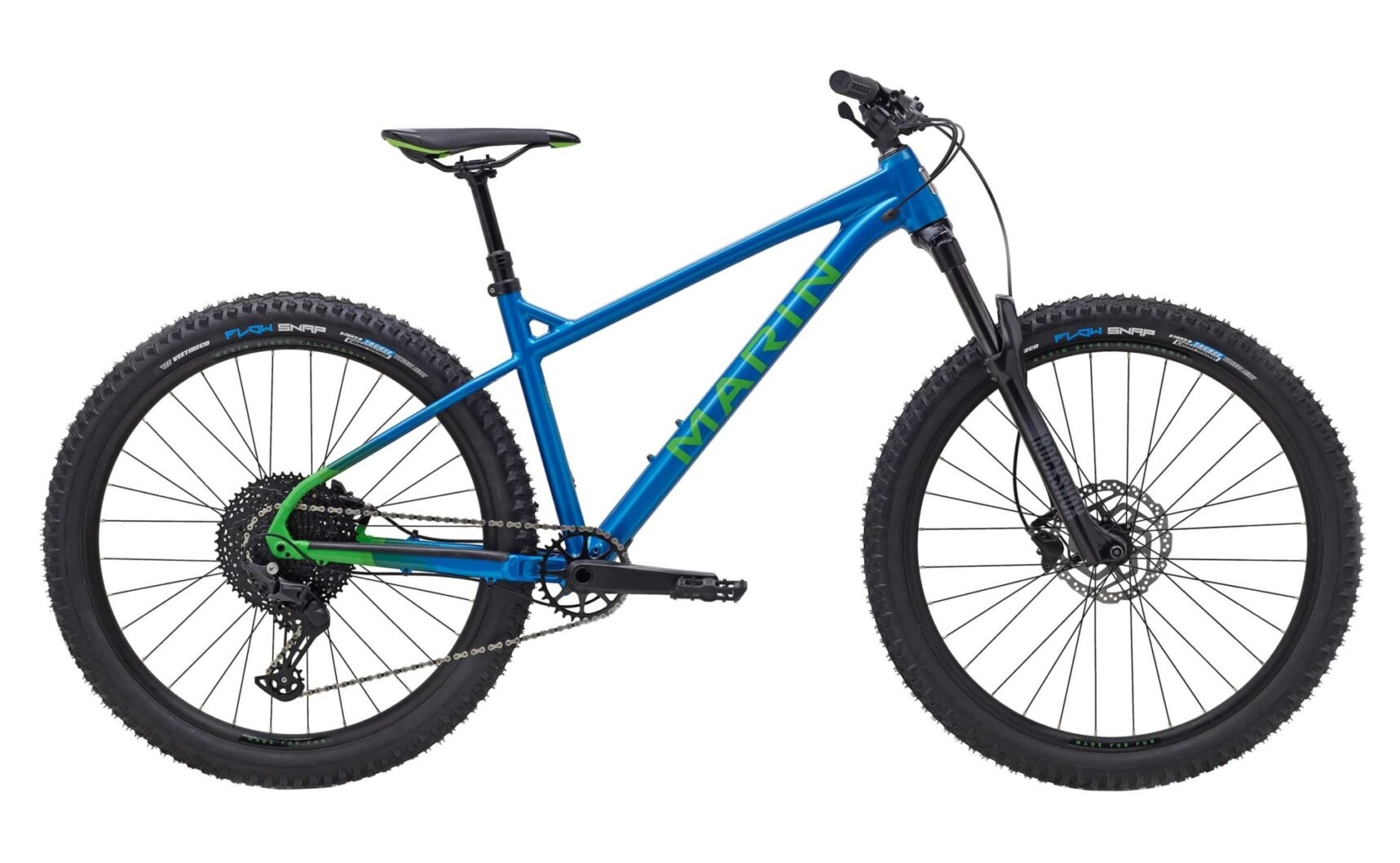
The San Quentin 2 gets upgrades like a Deore 11-speed drivetrain, a basic TranzX dropper post, and a thru-axle rear end. But what a rider is really going to notice over the SQ1 on a test ride is the RockShox Recon suspension fork. Long term my favourite upgrade the SQ2 buyer is getting is the external bottom bracket crankset. This model sells for 1950 CAD. That's 600 CAD or almost a 45% increase.
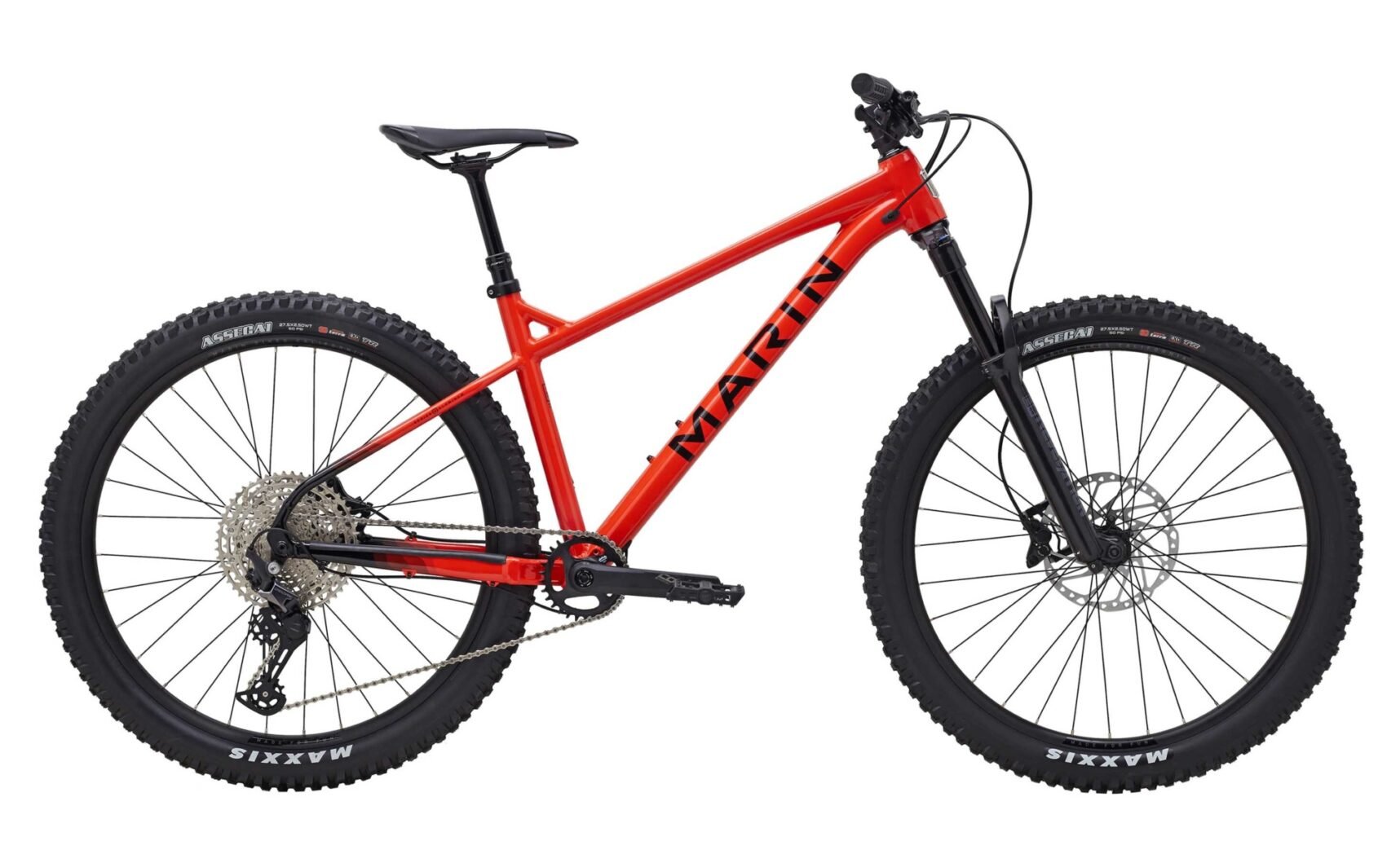
The San Quentin 3 gets Maxxis Assegai tires, a Deore 12-speed drivetrain, 4-piston Shimano brakes, a RockShox Revelation fork, and an X-Fusion dropper post. It's a no compromise, solid value, 27" wheeled hardtail experience that sells for 2900 CAD. That's 950 CAD or 49% over the SQ2. That's $1550 or 115% up from the SQ1.
SQ1 v. SQ24
I expended quite a bit of thought comparing this SQ1 to the stock build of the San Quentin 24", which is the best value kid's bike on the market. The geometry is fantastic and the bike is very well balanced in terms of front center and rear center. Being built around a 26" fork there are options for decent suspension or to use that old 26" fork you've been hoarding. Other than a pair of Chromag Radar pedals, I'd buy a pair of Maxxis DHF 24" tires if your kid is riding steeper trails but otherwise it's good-to-go.
The SQ24 sells for 1200 USD | 1500 CAD. It could use a couple of updates like better dropper routing and a reduced seat tube length. I also wish they had a frame-only option for folks with a box full of parts wanting to build their grom something rad. The main upgrade over the SQ1 is the Judy TK Silver air fork. When I was thinking the SQ1 should have an air fork as well, I was sitting on the idea that the SQ1 and SQ24 should share a build for simplicity's sake.
Since then I've realized the two bicycles share different use cases. The SQ24 is for mountain bike-addicted parents looking to balance performance with price as their progeny quickly overtake their skillset and are also growing out of everything constantly. The SQ1 is for folks looking for the best mountain bike experience for the least amount of money. Both bikes are going to be fun on Blue and even Purple-level trails with many Black-level trail features gradually coming into play.
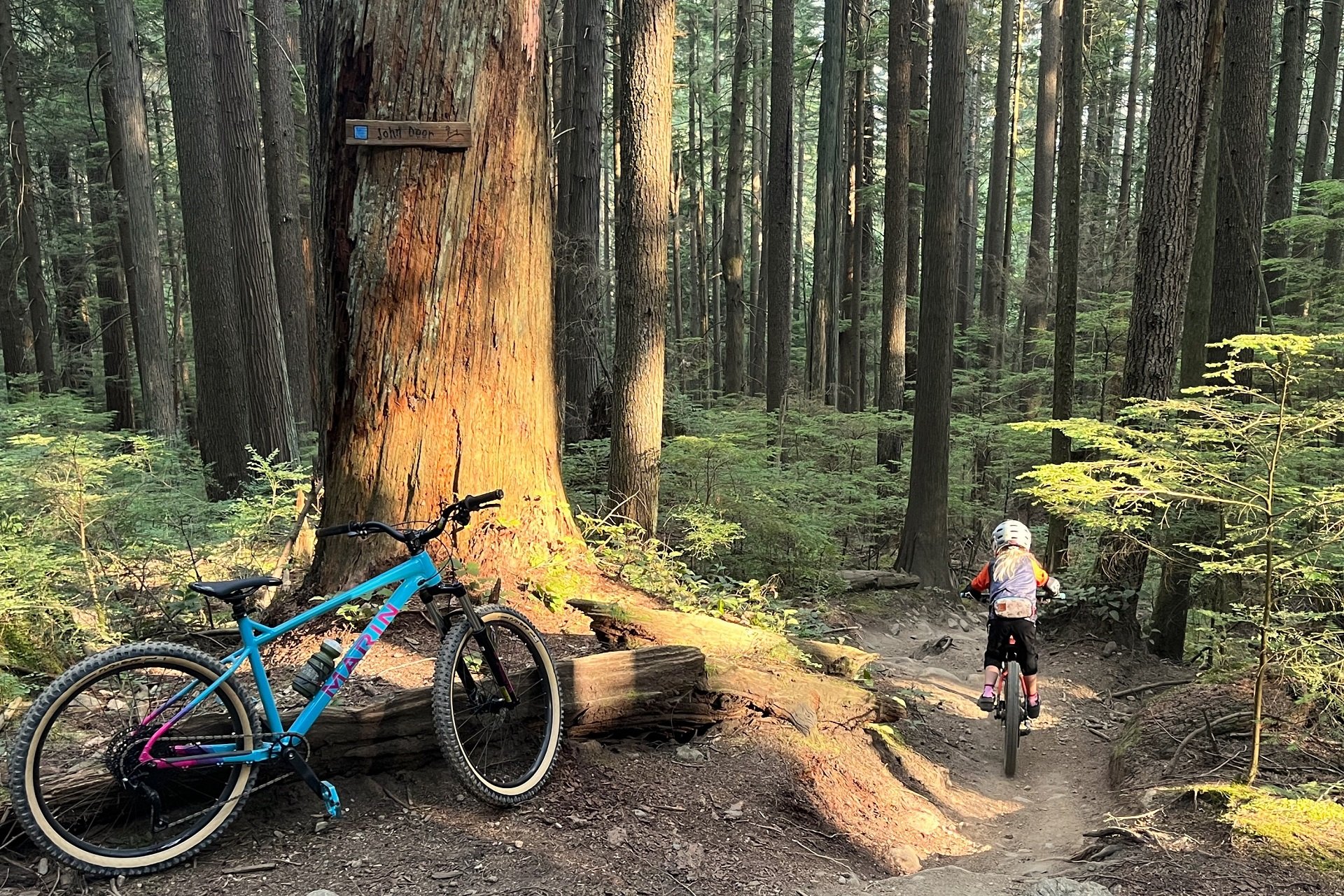
I'm not breaking any personal best times descending, but the SQ1 is plenty of fun on the Blue and Purple-level trails I ride with my kid. Even when I'm just on my own.
Larger Larges
I personally wish that the San Quentin had sliding or horizontal dropouts, but I recognize it would represent a significant extra cost that most owners would never take advantage of. Barring that, I would love to see size-specific chain stays. I'm not looking for a wheelbase to rival my Waltworks (I understand that this is a more all-rounded machine) but I think the current 425mm stays belong to the size small, and if we went up 5mm per size from there that would be quite reasonable.
On the note of sizing, I think Marin needs to add an XS and an XXL to the list but I recognize the XXL may be a harder sell, due to the smaller wheels. Even with an XS-XL range, I'd like to see the current sizes lengthened by about 10mm of reach and raised 10-15mm in terms of Stack height. This large fits a bit on the small side when the trails get janky but it's fun on flowy trails.
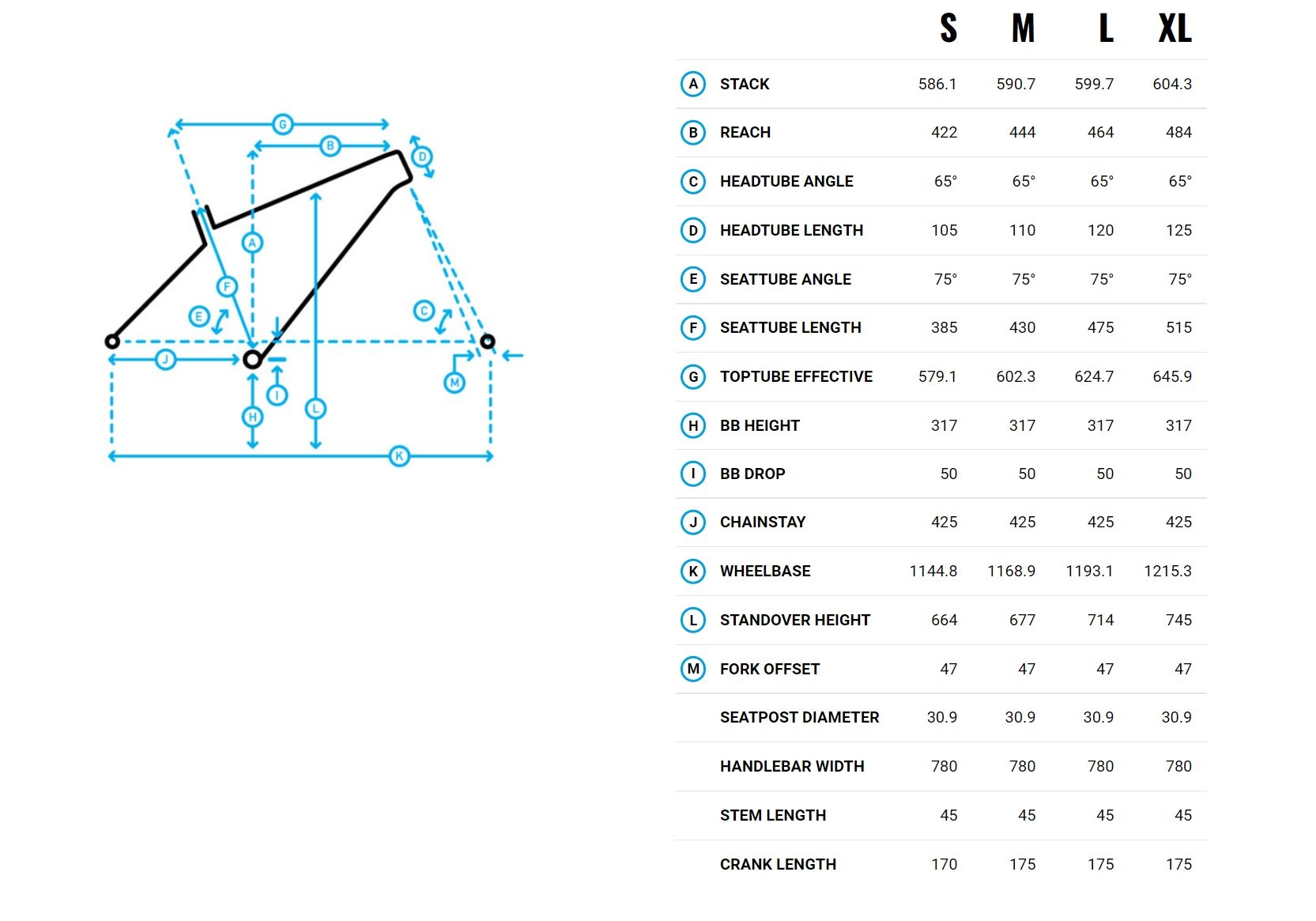
By the numbers. The geometry is remarkably well-rounded for a do-it-all hardtail mountain bike. I'd love to see an XS and XXL option added. And yes, I'd personally love size-specific chainstays and an extra 10mm of Reach and 10-15mm of Stack on each existing frame size.
The bike is fun and playful and I'd prefer to preserve that attitude while adjusting the balance slightly towards a roomier and more stable platform. If you're someone who looks at the geometry chart and thinks the reach numbers look fine, you may still agree that the headtubes could be longer. As with the other test bike I'm playing with right now, the Arrival 152, I find that with the maximum number of spacers under the stem I get a good riding position with the stock handlebar, but I'd certainly be happy to try a taller setup.
In the case of the Marin, I did that. Pairing a 76mm ProTaper riser bar, at 780mm wide, with a 50mm stem to stretch things out a bit. This pushed my effective position forward without having any negative effect on handling. With the change of position, the already quite decent saddle, became more comfortable as well.*
*The fact Marin can find a reasonably comfortable saddle to equip on a bike that sells for 1350 CAD doesn't speak well for any company running an ass-hatchet on bikes that cost substantially more.
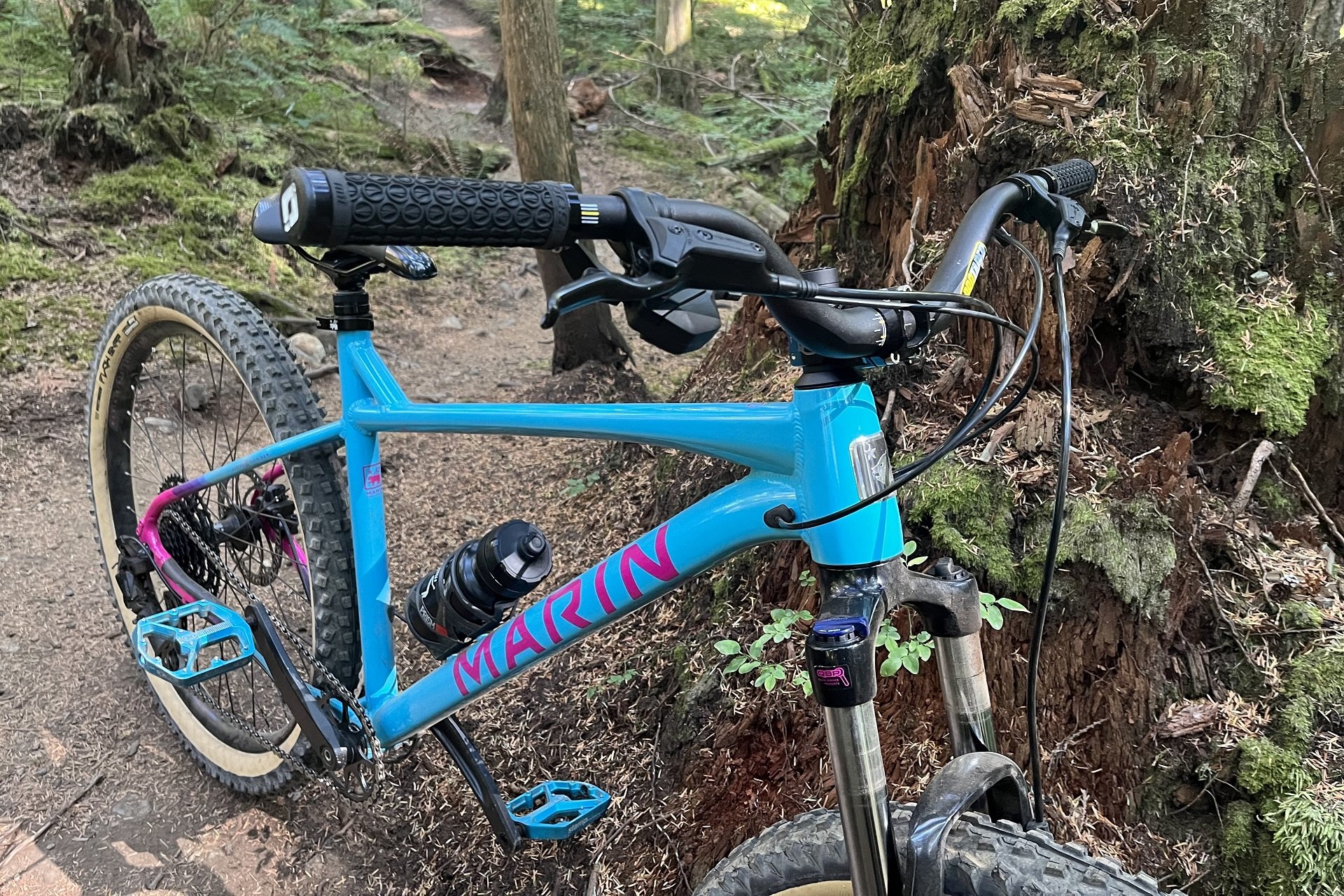
I haven't used full travel, but the fork does sag a fair bit when the trail gets steep. The tall rise bar makes it easier to compensate for changes in geometry on the hardtail as the fork moves through its travel.
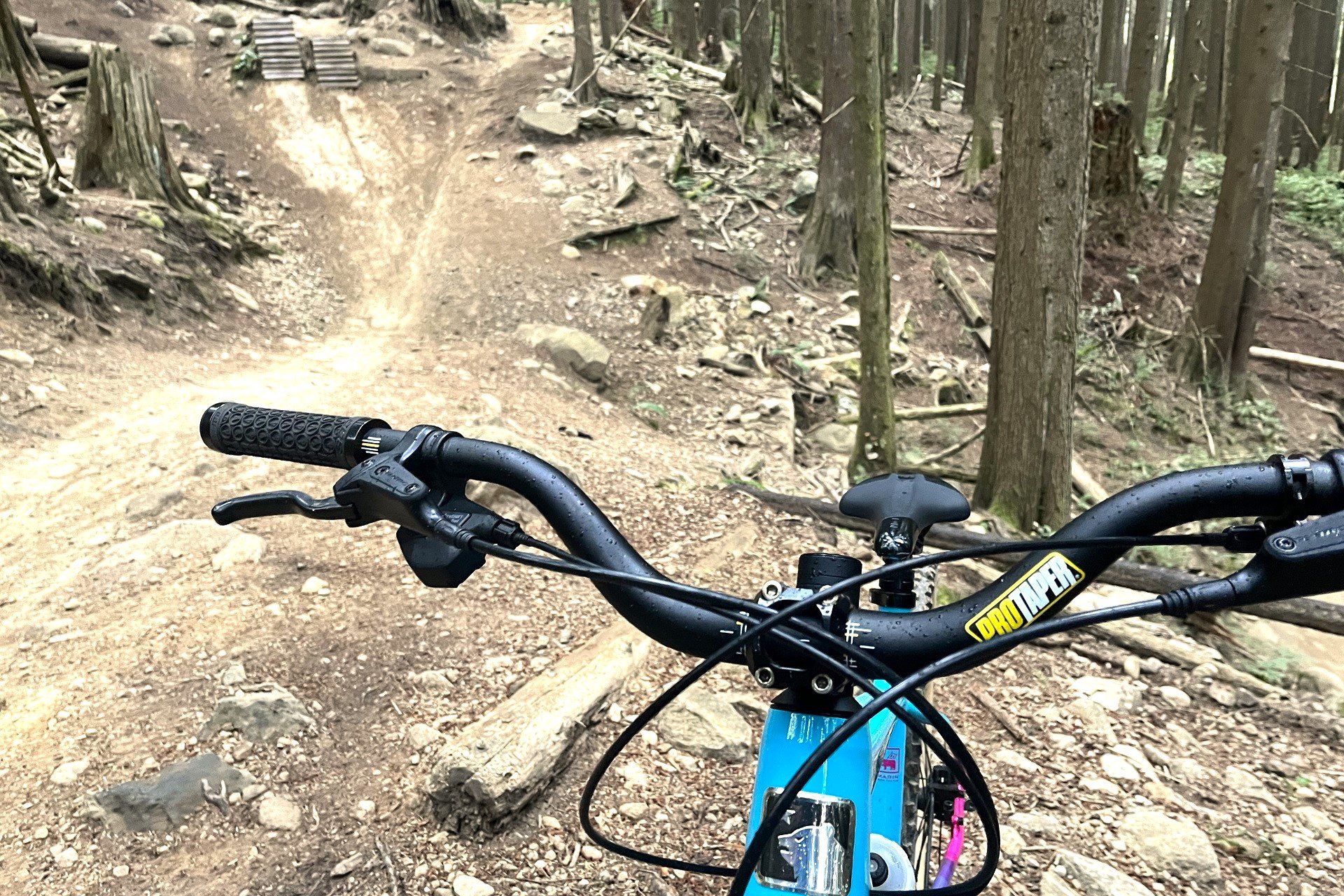
Some folks don't love the look of a tall riser bar, but for me, there's a certain nostalgia not to mention that the slammed 50mm stem and 76mm riser combination really dialled in the fit of the SQ1 for yours truly.
Hot For Mullet
How do you add some capability to a hardtail without taking away the fun pump-and-jump characteristics or adding to the price? The size large and XL SQ series could do well as mullets with 29" front wheels. Mullets are quickly carving a place for any rider who isn't super-tall that's looking for improved bike-body separation, an easier time feeling like they know how to corner, with most of the benefits, and in particular the psychological benefits, of the bigger front hoop.
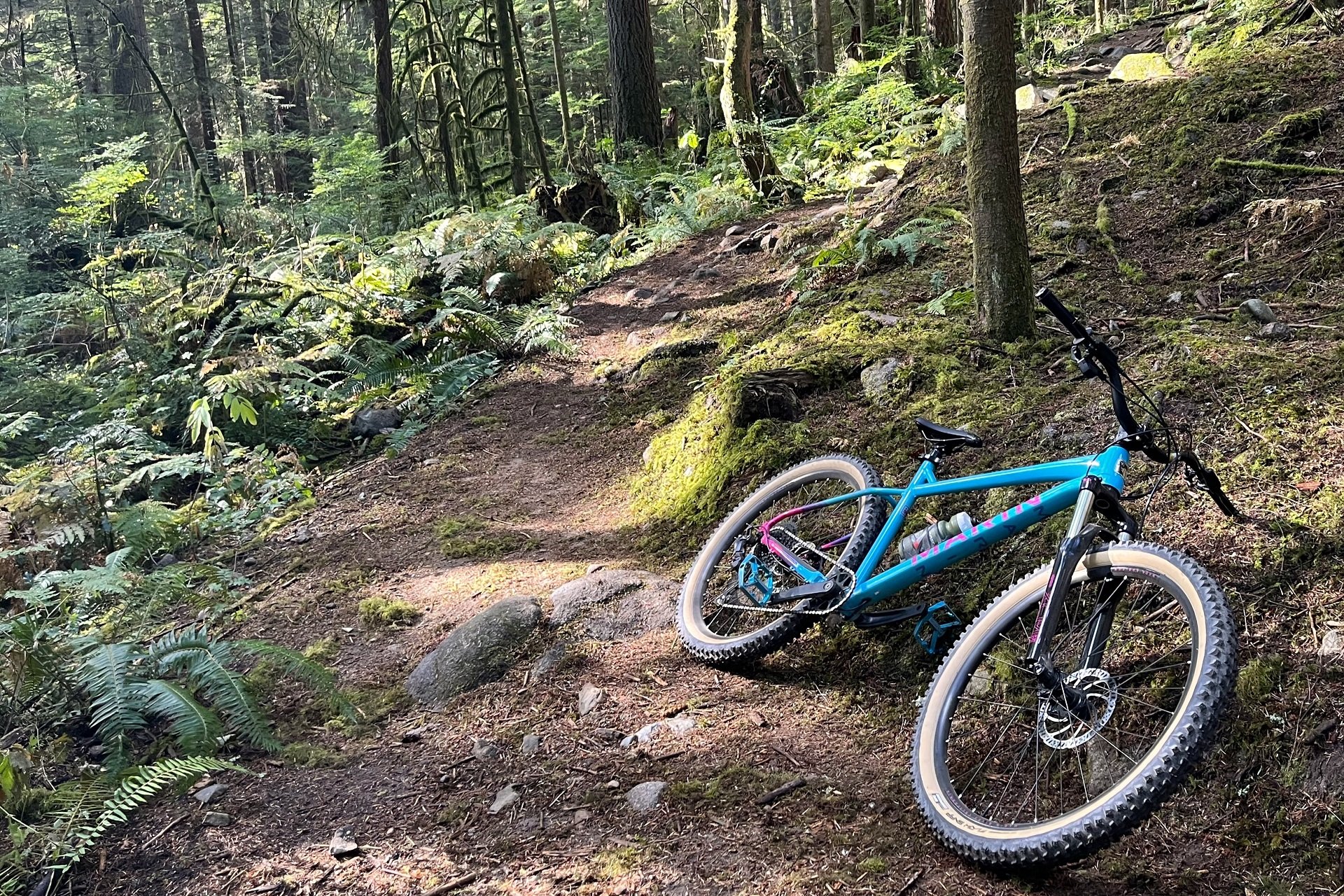
The perspective in this photo makes me think of a mullet bike - with a 29" front and 27" rear wheel - and I think the whole San Quentin lineup would be well suited for the mixed-wheel configuration at least in large, XL, and a future XXL size that I think would be nice to see for the next generation of the bike.
The Last Rides
On my last rides before writing this I'd reached a state of contentment with the SQ1. It's an easy bike to ride, and while the fork is heavy and far from sophisticated, it's also very predictable, as are the brakes and drivetrain. With the 50mm stem and taller riser, I found a happy fit with the size-large, but I'll note here that I'm very accustomed to longer frames and my foot position on my pedals shortens the effective reach some. With a tubeless setup, I even came to terms with the stock rubber, running about 30psi rear and 25psi in the front. I'd like to see a 24mm spindle crankset and a better narrow-wide ring, but only if Marin could make that happen without a significant price increase.
My biggest takeaway was remembering this bike wasn't made for me. When you're aware that you're riding trails on a bike that costs less than the suspension fork you're used to using, it's hard not to giggle. In the same vein, it's nice that I know I can recommend the San Quentin as a gateway bike to an aspiring or casual rider and know that, as they develop their skills and confidence, they'll be able to enjoy every Blue-level trail out there.
For more information on the budget-friendlier rig, in either this 'bold' or the alternate 'cold' colour option, check out the Marin San Quentin 1.

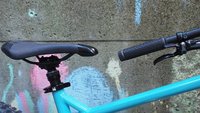

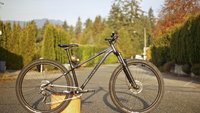
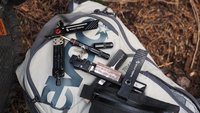

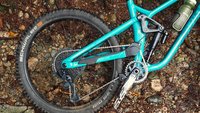
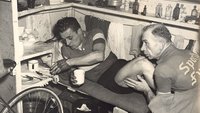
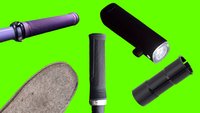


Comments
Justin White
1 year, 3 months ago
"I'd say a basic dropper would win over a fork upgrade"
Strong agree. And it fits with your "geometry is key" mantra. Good geo makes it easier to get your body in the right position, and a dropper goes a long way towards that same concept. I personally would always pick a dropper over suspension, but I also once owned a FlexStem, so... ;-)
Reply
Andrew Major
1 year, 3 months ago
It’s always funny to me how self-evident this is to everyone (everyone?) but me versus how long it took me to get here.
I can’t even blame the local riding being very pedal-and-plunge because it’s local riders I’m usually talking to.
Maybe it’s all the #1FG riding, but either way a good quick release and simple post had a lot of appeal until only recently when my kid started riding with a dropper.
My mind was blown at how quickly it improved her riding. Climbing and descending. She’ll pop her seat out of the way to get up on to a long uphill ladder bridge (24” hoops don’t bump-on as easily as big wheels) and then pop her saddle back to height to keep the bike (which weighs ~ half what she does) moving.
I mean, I clearly will take a dropper over a suspension fork but I imagine that forced to make a choice a lot more people would make the same decision than I would have expected 6-months ago.
Reply
andrewc
1 year, 3 months ago
I appreciate the reviews of budget-friendly bikes! As someone who loves to encourage people to "get into biking" but also shudders when I see how discouraging the price of new bikes are, having some affordable alternatives queued up in the back of my mind for when someone might ask what I recommend is always welcome.
The quality of North Shore riders and the bikes they ride is sometimes a bit detached from the folks out there who maybe aren't "bike people" but still appreciate ripping around on green/blue/purple(?) trails and are in need of an attainable, low-maintenance steed. There's room for people to like riding mountain bikes without being a Mountain Biker (capital M, capital B... if that makes sense?)
Reply
Lynx .
1 year, 3 months ago
Yeah, bike prices have increased quite a bit these days, I bought my first "proper" MTB, a Giant Trance3 2005 with LX drivetrain, DukeXC fork, Float shock, Hayes So1e brakes and some meah i19 wheels for $1400 US. Saying that, a Deore build from today, would perform almost as good as an SLX or even XT from years gone by, things are that good now.
Reply
Andrew Major
1 year, 3 months ago
This 1100 USD Marin SQ1, bone stock, would slay a 2005 Trance 3 down anything.
Reply
Lynx .
1 year, 3 months ago
Well, given just the geo I'd have to agree on that :-) I mean come on, The Trance that year had a 70.5* HTA LOL When I look back at steep stuff that I had "trouble" with, I'm not so surprised now LOL.
Reply
Andrew Major
1 year, 3 months ago
Makes total sense to me as it describes my youngest brother perfectly. He has no aspirations to ride trails beyond what is in his kid's wheelhouse which is easy Blue-level runs and riding around the campsite.
That said, I think a lot of riders on the North Shore would do very well to take a rig like the SQ1 out for some rides. Don't try to kill yourself, just choose trails that you know will be fun - like John Deer or Asian Adonis - and go out and ride them. It's an important perspective to have when talking to people about bikes. Whether it's people riding mountain bikes or new Mountain Bikers with limited budgets to commit to the activity.
I think pretty much anyone who can ride, for example, John Deer from top to bottom on their own bike would be able to do the same on the SQ1. Sure, not as fast as on their multi-thousand dollar FS bike but genuinely in control and having fun. It's important, I think, in distinguishing between need and want when helping a new rider choose a rig without, as you say, discouraging them based on price.
Reply
Niels van Kampenhout
1 year, 3 months ago
Great write-up Andrew. I like how you take us by the hand on a walk through changing perspectives to see the bike from the point of view of those most likely to buy and ride it.
Seems like a decent bike for the money. Looking forward to more reviews of affordable hardtails. It's a lot more interesting to see what bike brands can do at this level than at 10X the price.
Reply
Andrew Major
1 year, 3 months ago
Thank you, Niels. When I finished I had an urge to go back and re-write the whole thing more focused on the perspective of the most likely buyer. The piece also could have easily been a 30-minute read if I’d included everything I wanted to say.
Looking forward to more budget bike reviews as well. Would love to see some other NSMB testers on the program as well (wink, wink, nudge, nudge). Though I get it’s a bit like eating Spam when you can enjoy filet mignon instead.
Reply
Peter Appleton
1 year, 3 months ago
fair review, as you know the crankset/chainring is one of the most expensive OEM items when speccing bikes, not to mention Marin is down the list in terms of brands that gets the first available products in a industry plagued by shortages.
lastly you can imagine better than most (i have one myself too) its awesome to ride rigid plus bikes but Marin wants to sell units, 1000's of them. and a rigid bike with "balloon tires" (thats what they'll call em) will NOT SELL any units.
keep up the cool reviews
Reply
Andrew Major
1 year, 3 months ago
Thanks, Peter,
Marin has a lot more purchasing power than most folks think. They're a bit of a sleeping bear but as more and more brands experiment with screwing their dealer networks (think Specialized) I think folks will be surprised how many Marin bikes they see on dealer floors. They're very committed to the IBD.
To your other point, yes cranksets are a place a lot of brands cut corners specifically because the crank/BB/ring is a surprisingly expensive part of any bike spec. Marin has been very creative with this in the past when min-maxing builds and has done some solid house-branded options. I'm not looking to see Aeffect R cranks on a $1100/$1350 bike but I still think it's worth pointing out that the crankset is the one obvious shortcut here.
And yes, I've totally come around to the fact that the suspension fork (and in particular this coil suspension fork) was the right spec. choice.
Reply
fartymarty
1 year, 3 months ago
Andrew - I get your point on the 300lb guy v 70lb tween... Spring rates would solve one of the issues - which was probably my main issue with the fork - no point having a suspension fork that doesn't work. The weight I could have lived with knowing it was a budget fork.
It's probably the toughest bracket for a "real" mtb company as there is nothing spare.
Reply
Andrew Major
1 year, 3 months ago
Nothing to spare and hard choices. There is so much garbage out there and better an easily serviced coil fork that barely moves but lasts ~ forever versus a crappy air fork that can’t be fully serviced that’s dead in under a year.
I think having multiple rated available - even if all the bikes come oversprung OE - is the answer. I’ll follow up.
Reply
Andy Biggs
1 year, 3 months ago
I really rate this bike.
I bought one of these for my 10 year old son and it's been an excellent bike for him to progress on. The main upgrade we did was buying a second hand Rockshox air fork and popping that on. The original fork was super heavy and didn't compress under his weight. I agree with your comment about it needing a suspension fork, even if it's not very good. It's not about the performance it's about the look. I could never have convinced my son to ride a fully rigid bike. We also replaced the tires as they wore out with Maxxis ones. I've also been super impressed with the drivetrain, i'd never heard of Microshift before, but it's been very durable. My son managed to bend the derailleur cage with such a big impact that it was split open. I folded it back into a more normal shape with vice grips and it's shifting really nicely again. I think having a smaller amount of gears means this drive train doesn't need to be so perfectly aligned to work well. Also weirdly the bike is cheaper here in New Zealand. When we bought it a year ago it was NZD1200 (CAD900), I notice it's now selling for NZD1400 (CAD1080). I love that Marin makes proper bikes in this price range. I'd also recommend it to anyone looking for a good value hardtail for their kids.
I'd also like to say I love this site, it's such a good resource for information on mountain biking in general. It feels way more honest and real than the other sites I read about mountain biking. One of the posts on here about bike packing, inspired me and the kids to head out on an overnight bike ride earlier this year.
Reply
Andrew Major
1 year, 3 months ago
Cheers! Great photo too.
I think I’d just roll back to the fact this bike is worthy of upgrades. Used fork or new fork down the road and etc. 100mm travel 29’er fork with mullet wheel? Maybe… but yeah, there’s nothing quality or geometry wise that would (or will) keep me from playing with it.
How much travel did you go with for the RockShox?
Reply
Andy Biggs
1 year, 3 months ago
I set the travel at 140mm and also swapped out the fork oil for lighter weight oil (Reverb oil). The idea being that hopefully the compression and rebound would be faster/lighter for his weight. Not sure that really made any difference though.
Reply
Andrew Major
1 year, 3 months ago
I was thinking a bit of an over-forking to 140mm would make sense geo-wise. Cool!
Reply
Justin White
1 year, 3 months ago
Yes, "worthy of upgrades" definitely should be a huge plus here. The first "real" mountain bike I got (after quickly demolishing a "department store bike"), and the first I paid for myself, was a Bridgestone MB-6, literally the least expensive in that line-up. However, one of the big factors that let me go for that ASAP instead of saving for a higher end model, was that every single fancier part available would just fit.
That got lost somewhere as department store type cost-cutting creeped into low-end "real" bikes: no tapered headtubes, no thru axles, POS forks, useless full-sus designs. So many sub-$1000 bikes in the last 15ish years just could not be upgraded in any significant way, and many had just ancient geometry.
It's so refreshing to see new "cheap but real" bikes that have modern geo and can accepts upgrades of pretty much every part. Only special thing it seems an SQ1 needs is a wheelset that has adapters for QR141, which is a reasonably common thing. So good!
Reply
Andrew Major
1 year, 3 months ago
QR, especially for hardtails is great. I admit that early on 141 made me nervous re. after sale support but in reality there are plenty of options either on a budget or premium level for hubs/wheels.
Would certainly rather see money sirens on other upgrades than a rear thru-axle.
I come from the same place with bikes - buy something worth upgrading and replace parts as they break, wear out, or you outgrow them in terms of abilities or expectations.
Reply
Justin White
1 year, 3 months ago
Oh, for sure, I have nothing against QRs on hardtails.
Though I do find it odd that the SQ1 is actually a different frame from the the 2, 3, and frame kit. I find it hard to believe that the cost savings of not doing a thru-axle rear is not completely wiped out by the cost of a developing completely different frame that is only used on one model. Unless they're considering it a value-add for their typical SQ1 customer to not have to deal with a thru-axle... or that the cost of building the SQ1 frame is so much lower that the other frame that it amortizes its own development...
Reply
Andrew Major
1 year, 3 months ago
They did the same with the Hawk Hill the year I tested the most basic version. All that’s different is dropouts (not spacing) and it apparently saves enough money on the frame and the wheel spec. both to make it worth while.
Marin is a lot bigger company than folks think and the 141 dropouts are used elsewhere so I’m sure it adds up over many SQ1 bikes.
LWK
1 year, 3 months ago
I'd be inclined to think that parents are a pretty big target market for the entire SQ line of bikes (not just the 24" model). It pretty much has to have a suspension fork, no matter how basic, as no 14y old is going to ride a rigid, balloon tired bike (as described above). That is for their middle aged weirdo uncle... :^) Also, maybe the entry fork and lesser brakes might be ok for a smaller, lighter teen rider? Even if they do beat the s*** out of the bike?
My observations based on being directly involved in a youth riding program. The general move "up market" for kids and and teens bikes is very noticeable since COVID. Kids that used to be on really cheap or old second hand bikes are now on Marin SQ or Rift Zone style bikes. And the number of young teens (13-15y) riding $5-6K (and up) bikes is astounding.
Reply
Lynx .
1 year, 3 months ago
I say lack of good salemanship at dealers. All they'd have to do is let a kid ride a bike with crap sus fork and then one with rigid & PLUS and see how much lighter, responsive it is and also that it gives as much comfort about as a cheap fork, just without the weight and uncertainty of not knowing exactly what will happen if you hit something.
Reply
Andrew Major
1 year, 3 months ago
I don't think any level of back-to-back ride is going to sell teenagers on the practicality of a rigid fork over a suspension fork. Cool is cool, lame is lame.
I also again note that for the margin dollars in this case it doesn't make sense to fight for rigid SQ1 sales when the bike will move easily with the stock SR. Also, as noted elsewhere, the coil SQ fork is certainly more forgiving than a rigid Plus setup for riders who don't have a solid skillset.
I'd love for rigid to be the right choice here, but I don't think it is in the case of the SQ lineup.
Reply
cheapondirt
1 year, 3 months ago
My favourite thing about the San Quentin is you can buy the frame. It feels kind of audacious for a smaller-wheeled aluminum hardtail from an American brand. Even more so when considering the price and target audience of this trim level reviewed.
At $639 CAD it's a great candidate for a "winter bike" with all the components off your expiring 650b FS. Or, make it a rigid mullet SS and fulfil those esoteric MTB dreams quite affordably.
Reply
Andrew Major
1 year, 3 months ago
I agree, it’s a solid choice for the money. The El Roy is very impressive as well for the person with a broken 29” FS frame, or pulling the parts off one to rest it for the winter.
$880 CAD for the frame. Personally, both frames are missing sliders but how many people really are going to #1FG them or care about trying longer rear centres. “Who is the bike made for?”’ (Since it’s not made for me) is a question I been asking a lot with current reviews I’m working on.
Reply
albert03
1 year, 3 months ago
RSD Middle Child, sliding dropouts and all, $750 USD for the frame. Pretty good deals on complete bikes too. Just sayin'.
Reply
Andrew Major
1 year, 3 months ago
RSD does some cool stuff.
Reply
justfrogurt
1 year, 3 months ago
You should also visit the inspiration for that bike's name up in Petaluma if you are in the area, El Roy's taco truck and their restaurant are delicious.
Reply
Andrew Major
1 year, 3 months ago
Neat, I didn’t know the story. I do love tacos.
Reply
Lynx .
1 year, 3 months ago
Andrew, I'm going to have to STRONGLY agree with you about the fork idea on budget bikes, definitely don't put a 7lb, almost POS sus fork on, instead put a nice steel, rigid with clearance for good 3" rubber on at least an i35 rim. Also, as you suggested, running a mullet on this particular setup would make even more sense, but def with no less than a 2.6" outback, preferably a 2.8".
I clicked on the link to the El Roy, had not heard about that one yet and was actually getting quite excited seeing a frame only option, then went to the geo chart and had to shake my head as I read the 78* STA :facepalm: Guess these would only be used to suffer the climbs to "enjoy" the descents :skep:
[Editor's note] Andrew, you need to do a quick check over for spelling mistakes lad, there's a few ;-)
Reply
Andrew Major
1 year, 3 months ago
I ended up strongly disagreeing with me about rigid forks if you have a second read. If the bike was for me, or you, then absolutely. But as a number of folks pointed out to me, the person actually buying this bike is only buying it with a suspension fork. And given that, I think the basic coil provides the right mix of movement and simplicity.
For the record though… It’s not that I don’t think that said casual or aspiring mountain biker couldn’t have fun with a rigid fork, they just wouldn’t buy the bike.
[Thanks. I’ll give it another read through when I’m awake. Sometimes you stare at your own errors late enough/long enough and they look tickety-boo]
Reply
Lynx .
1 year, 3 months ago
I read it thoroughly and got you were swayed, but I think that a rigid fork & PLUS setup is the way to go in the <$1200 bike category, it's just that the bike shops don't do their job properly and explain the benefits of it and that they'll get about the same "compliance" but with more predictability.
That being said, I don't know how "good" or not that fork is, so maybe it's OK enough for the avg beginner rider. My problem comes when your not avg, i.e. avg person is looking to buy the bike, you know, the guy or gall who's well over the rider weight the fork was designed for, or the smaller person who's way lighter, then there's no adjustment.
As to the dropper, you can pick up a BrandX from CRC for between $90-120 US and from the experience I've had with them, they're no worse than any of the other cheaper posts on the market in terms of weight and tolerance. Whole heartidly agree that getting the saddle out of the way will help a lot more than a new fancy fork.
Again here's where I go Rigid & PLUS, WITH a dropper for the same price - I'd rather have the dropper and no sus, than the other way around and then later on spend $500 on something "decent".
Reply
Andrew Major
1 year, 3 months ago
Smaller and way lighter is certainly more of an issue given I haven’t bottomed it yet. But the experience with the basic coil SR fork is much better than expected.
———
You know my rigid MTB credentials. There’s a reason I went straight to that track. Rigid, Plus rubber, dropper, gold!
Talking to different folks I know in shops now, riding the bike more, and thinking of my years selling bikes in shops I came around to the basic coil fork in a firm way. I think it’s just too hard of a sale, especially for the limited margin dollars, for shops to convince the average buyer of this bike (I.E. not us) to go rigid over suspension. And even then, in most cases it would be the shop employee selling the bike that would work better for them, not their customer.
For a casual rider or aspiring rider, the SR is still much more forgiving of big screwups than a rigid/+ setup. Considering skillset and learning curve on our local Blue-level trails I think a newer rider is going to have more fun on this SQ1 compared to the one I’d rather buy, with a rigid setup.
Reply
Lynx .
1 year, 3 months ago
Maybe I'm still realing from my own experience 18 years ago when I got my first "official" MTB and was sold an DB CoilX FS instead of a HT or even better a rigid, for measly budget I had. The fork on that thing was deadly AF, you never knew what it would do, might actually work and compress a bit or all the way or not. FYI, my bike if sold in the US back then was a <$500US model, so to be expected, but I've since looked at and weighed more modern alternatives on the around $1k mark and they're still damn heavy in the 6-7lb range, which makes the front end feel like lead, hard AF to lift the front or move it about, not fun.
Reply
fartymarty
1 year, 3 months ago
My daughters Spec Rockhopper came with a fairly lowly Suntour coil sprung fork. I could barely get it moving with my 95kg of heft therefore she had no chance at about a third my weight. It also weighted 3kg. I ended up swapping it out for a cheapie ebay fork (air sprung) which was a whole lot lighter and moves when she is on the bike. It still isn't great but at least it now works for her.
I get that mountain bikes need bouncy forks but they need to work and not be an absolute boat anchor. I would have rather had a rigid fork and pocketed the extra to put into a propper bouncy fork - or at least had the option to pick which fork I wanted.
Thinking about it a bit more - if I were a teenager buying this bike would I want a suspension fork (no matter how shitty) or a rigid fork - I would take the suspension fork in a heart beat as it looks cooler even if it doesn't work and weights a ton.
Therefore i'm a bit divided on it.
Andrew Major
1 year, 3 months ago
@Marty
This is certainly an issue and it largely comes down to any one size fits all approach where, for the extreme example, a size small bike needs to ‘work’ for a 70lb tween and a 300lb dude.
You’re never going to see a lightweight & strong fork at these prices and again only a more sophisticated buyer is going to choose the rigid bike.
I do think SR should offer multiple rates of coil spring and make them easily changeable. But there’s also a certain amount of want more/spend more going on.
Originally I planned to include a whole section on how much easier it would have been to review the SQ2 - air fork, 150mm dropper, etc. but the piece is already long without saying everything I want to say.
Lynx .
1 year, 3 months ago
@FartyMarty - 100% absolutely agree, the springs in most of those forks and how over built they are is insane, do not get why the brands don't go to the companies producing those "cheap" air forks instead. I've seen quite a few reviews of them and they seem to do quite good and definitely better than a one spring fits all approach.
Jeremy Hiebert
1 year, 3 months ago
@fartymarty I was going to say the same. The spring rate on my son's Suntour XCM was too stiff for me. We took one spring out, and that was pretty close for him. In theory, they offer softer springs, but were out of stock. We also got reeeally good at the clean 'n lube process on that fork, because after about five rides, it would be gummed up and almost unusable. After a proper clean like Andrew showed above, it was workable for a few rides. But overall, a total POS fork and his Norco had a similar spec with a wretched Suntour crankset that fell apart, so it wasn't really worth upgrading.
JT
1 year, 3 months ago
As a former bike shop guy, I had convos with customers who thought Trek 800s were too expensive. I listed out the reasons why what we offered was better than what one would get a big box, and it just wasn't in a lot of folx wheelhouses. One guy who actually (partially) took me up on 'buy from Wallyworld but have us assemble it' totally ignored the key part of avoiding anything with suspension but instead find the full rigid bike that costs as much as the suspension bike does. Needless, it was a hunkahunka burning crap.
All that is to say that folx want what they want, and the less insight they have into the how's and why's things are priced the way they are the less they care as long as it has that thing they insist on having at their price point. Ignorance is bliss, and it usually isn't until later that the joy of cheap price is overshadowed by poor quality. At least they're using Suntour, a brand with global reach, decent enough parts availability, and unparalleled ease of service.
Reply
Andrew Major
1 year, 3 months ago
To your point, I hopefully didn’t come across as indicating $1100 USD | $1350 CAD is a cheap bike.
To me the SQ1 has the right combo of price, geometry, and components to call it a solid value/bet for a lower price off-road worthy rig. It’s still an investment for a lot of folks.
Reply
Andrew Major
1 year, 3 months ago
On the subject of the 78* STA, and knowing my preference for slacker setups including on my own custom rig, I’ll have some things to say in my upcoming SQLab Infinergy review. I’d like to keep my powder dry until then.
Reply
AverageAdventurer
1 year, 3 months ago
I believe we're on B05S pads now.. I don't know if anyone had tried them as of yet, maybe they're good?
Reply
Andrew Major
1 year, 3 months ago
HAHAHAHA. Who can keep track?
I know the KoolStop sintered pads are what they are, so it's an easy recommendation.
Reply
Mark
1 year, 3 months ago
Cool bike, too bad about the name they chose for it though.
Reply
Please log in to leave a comment.